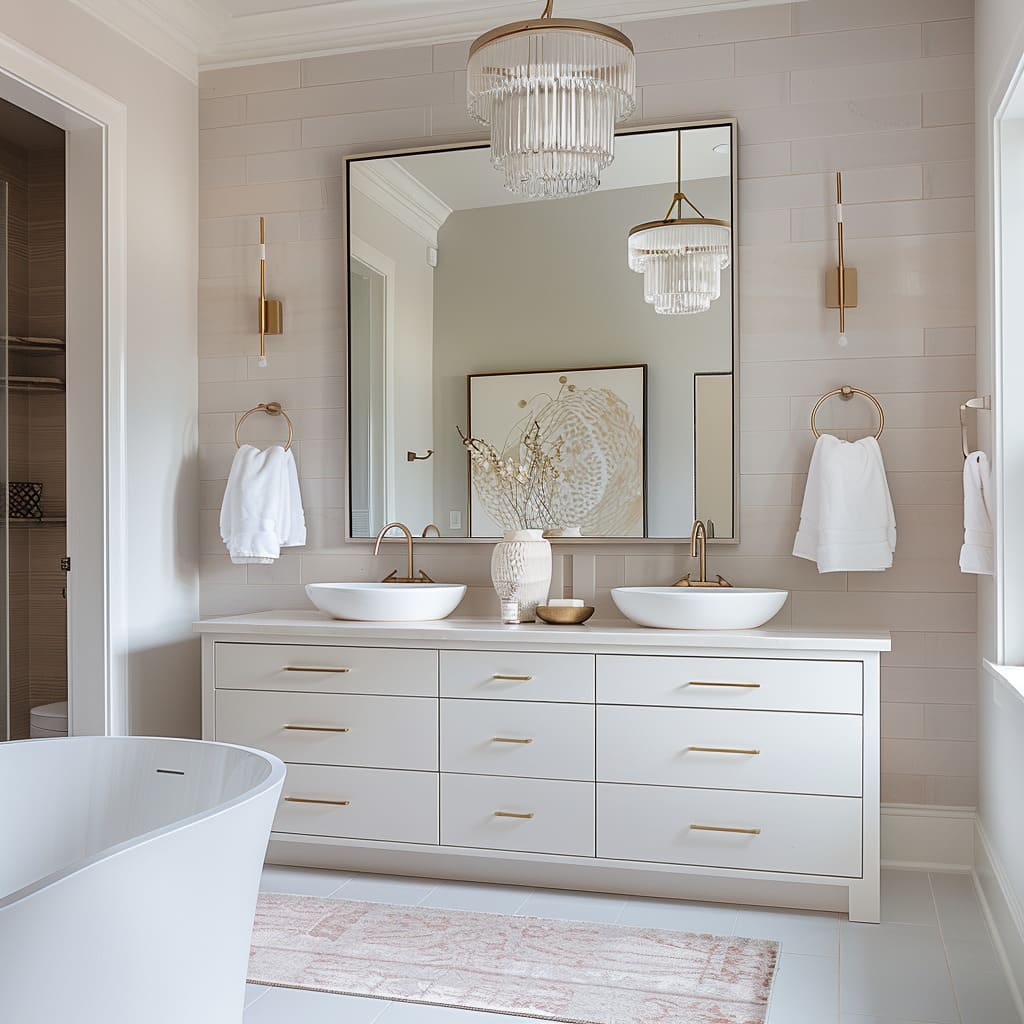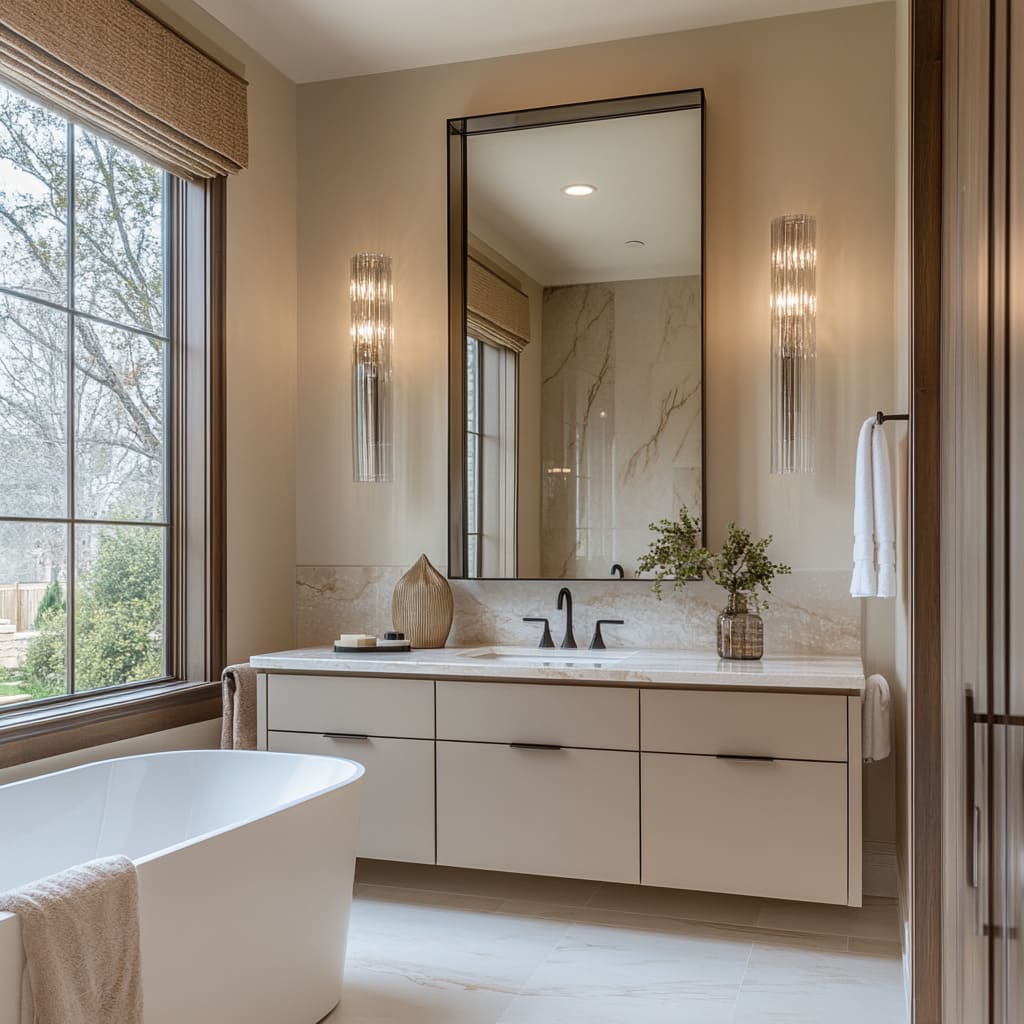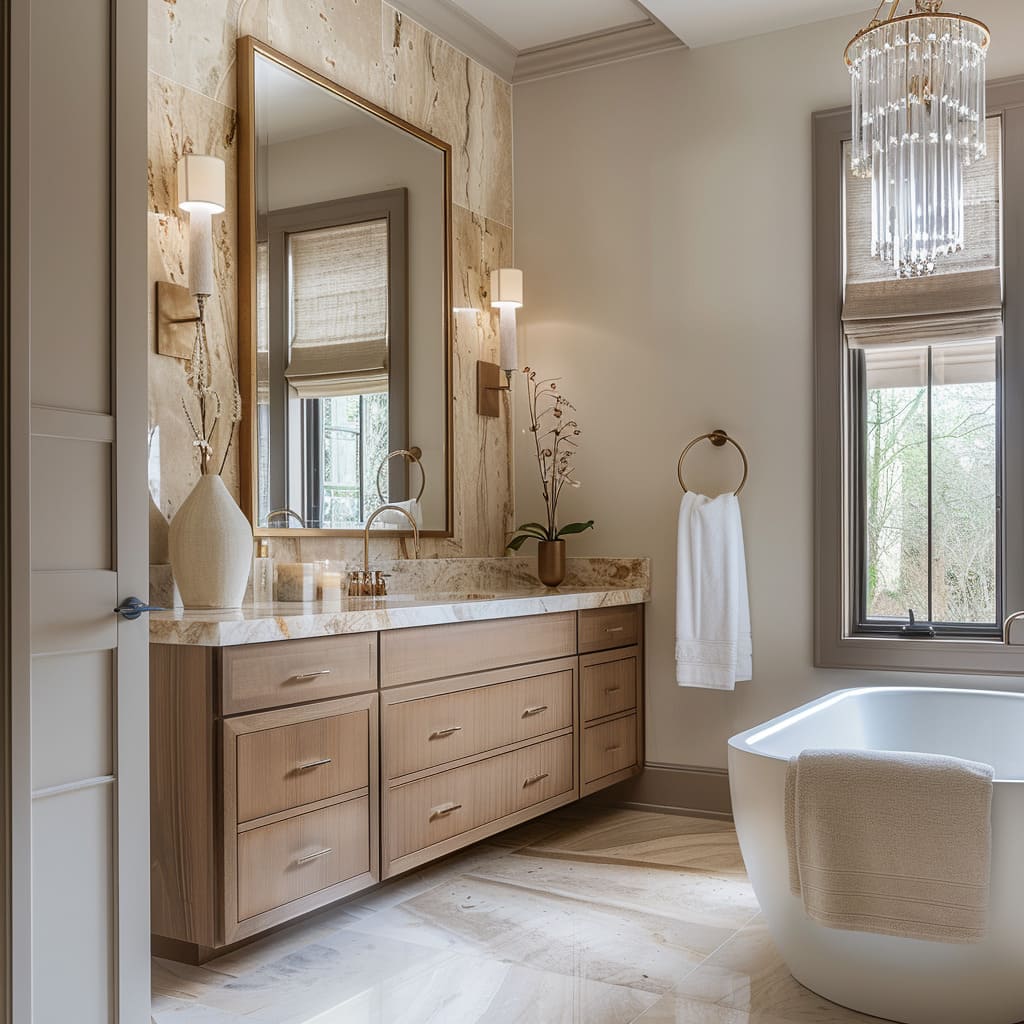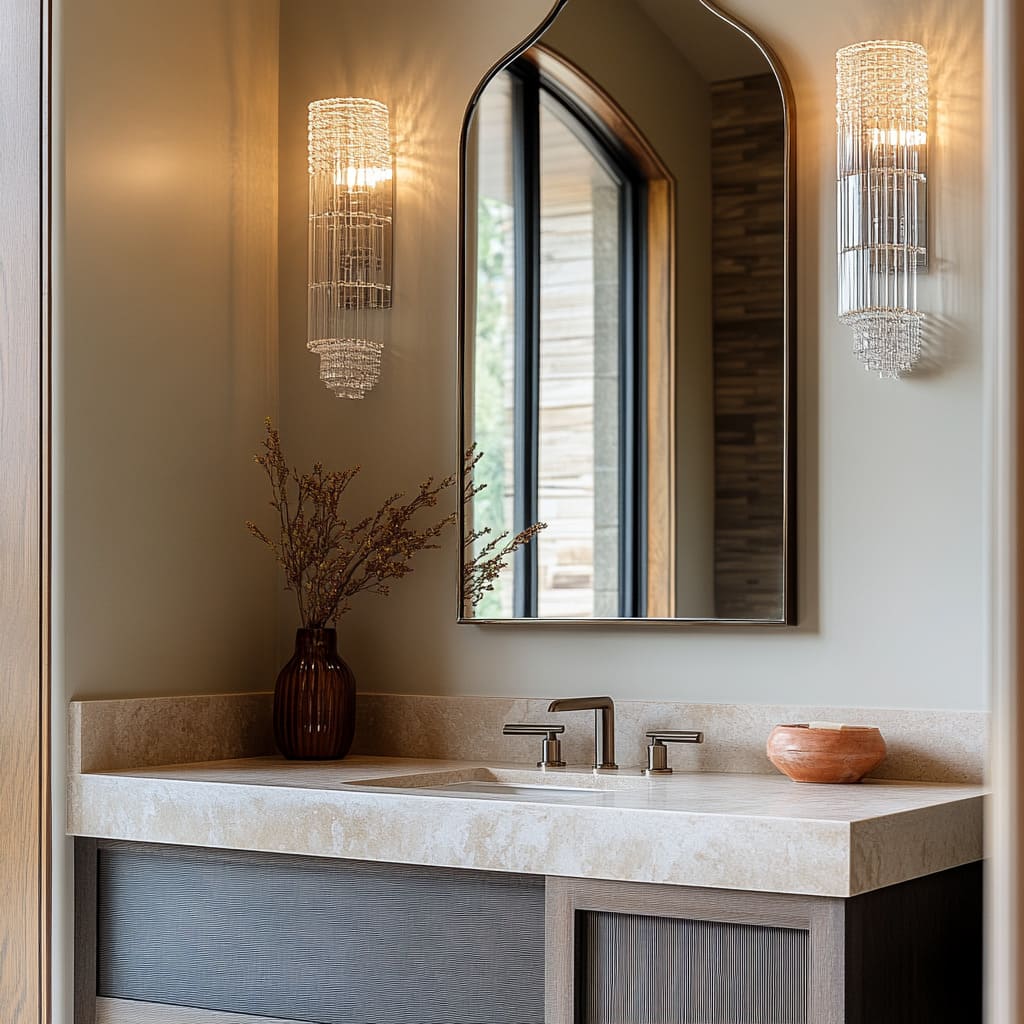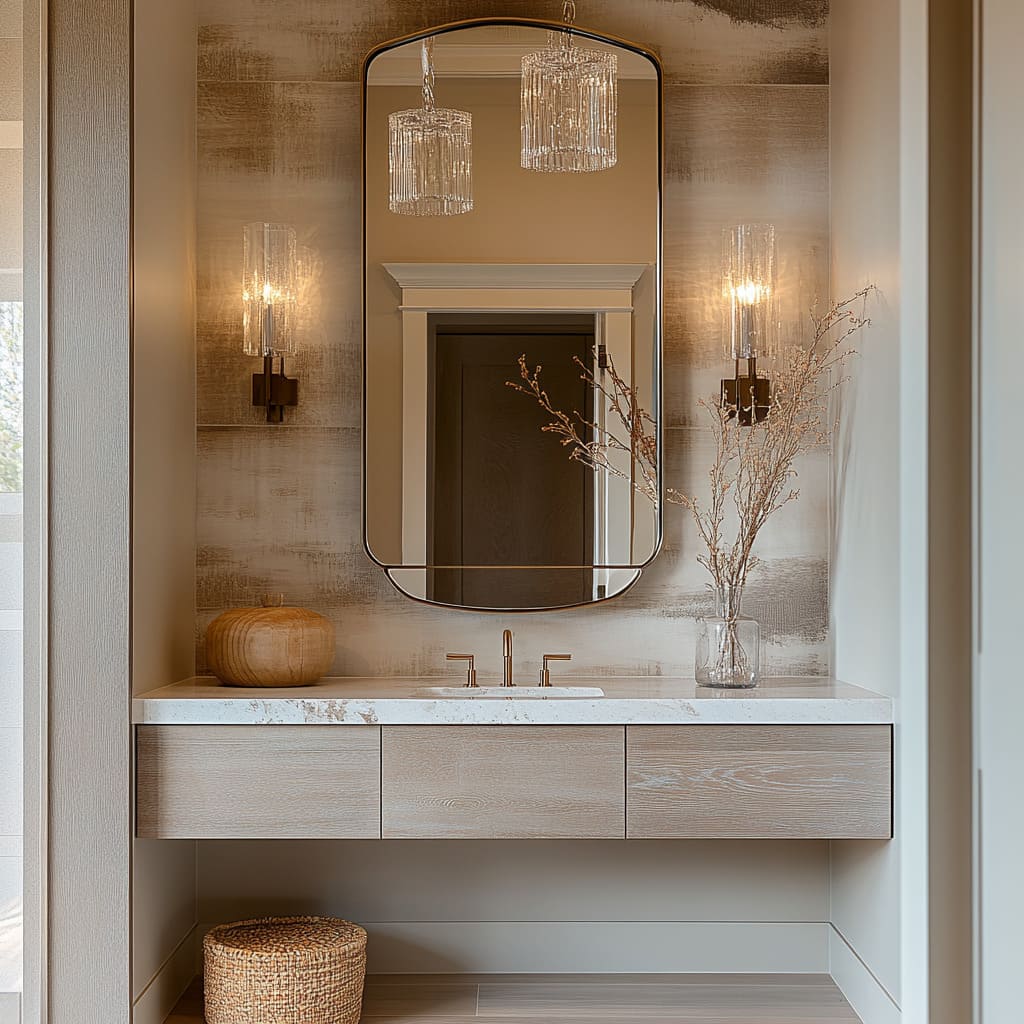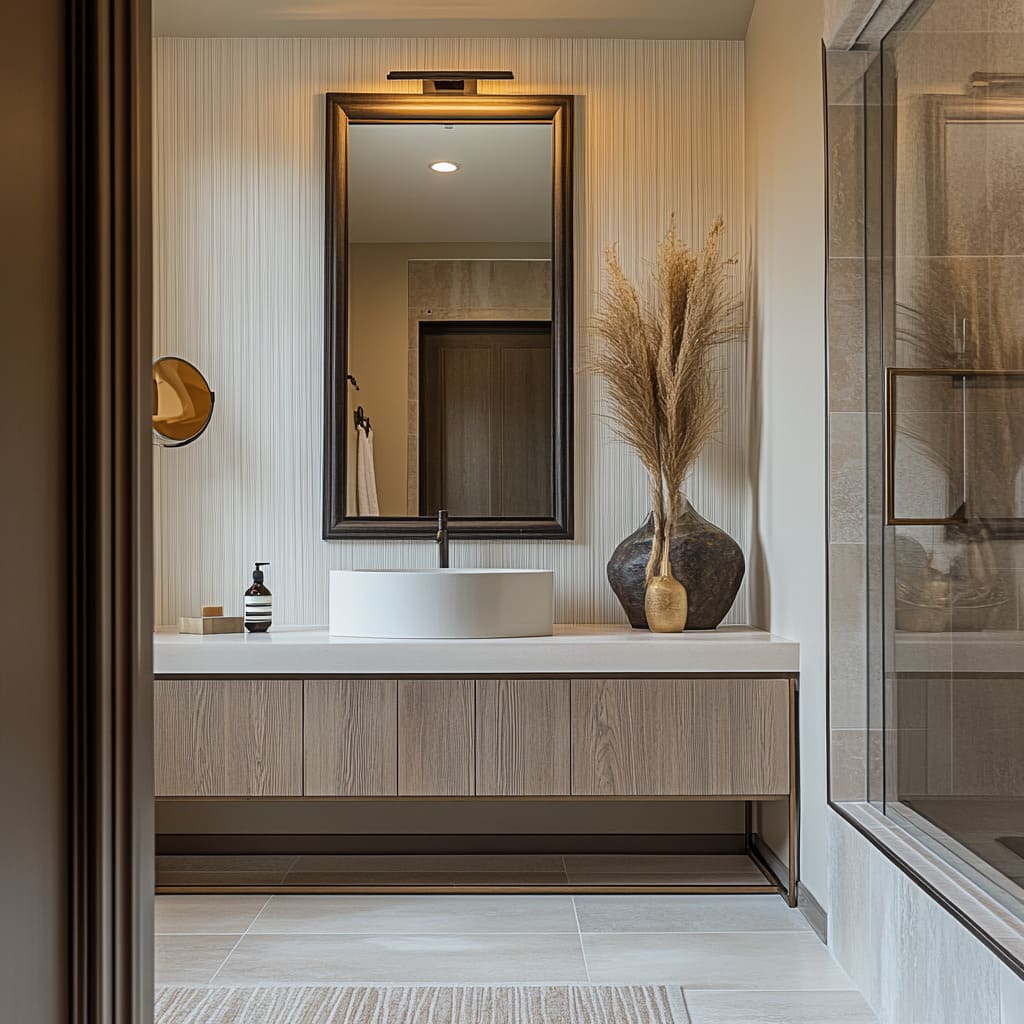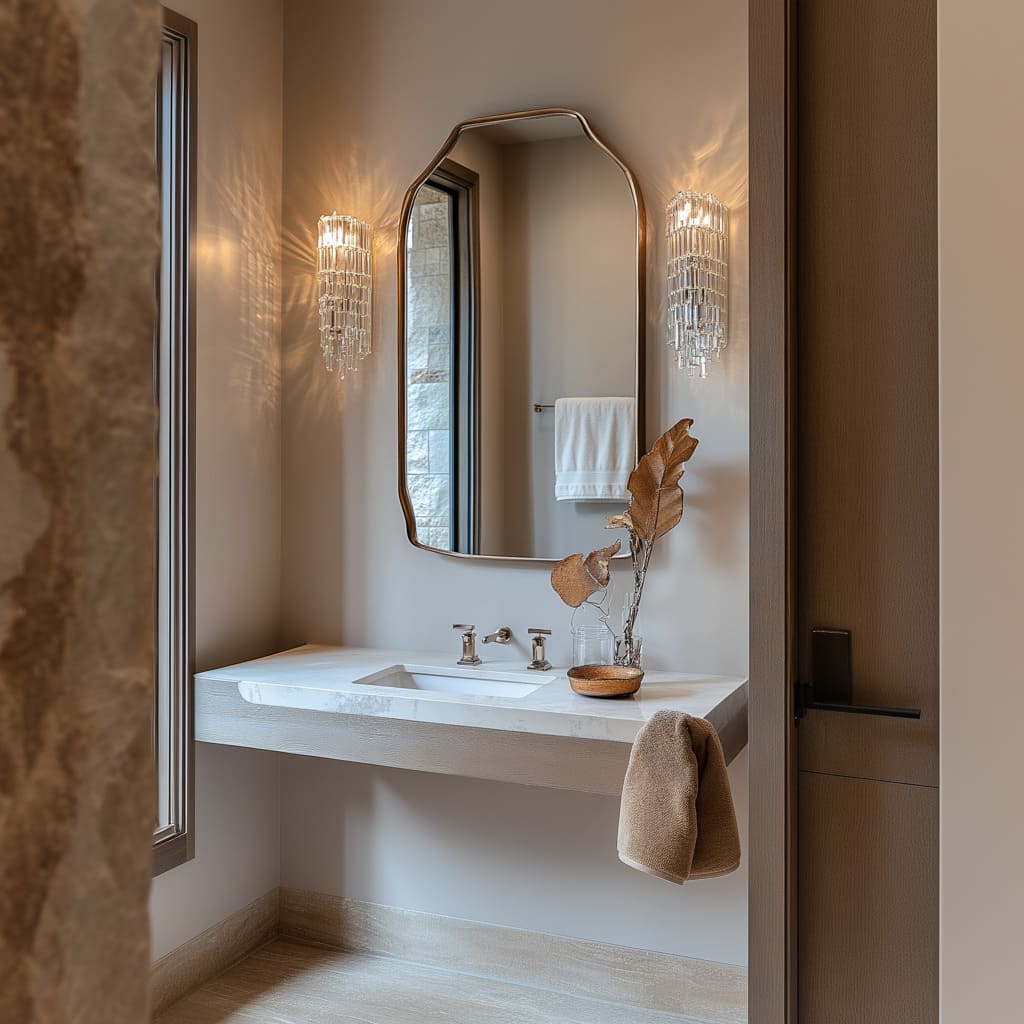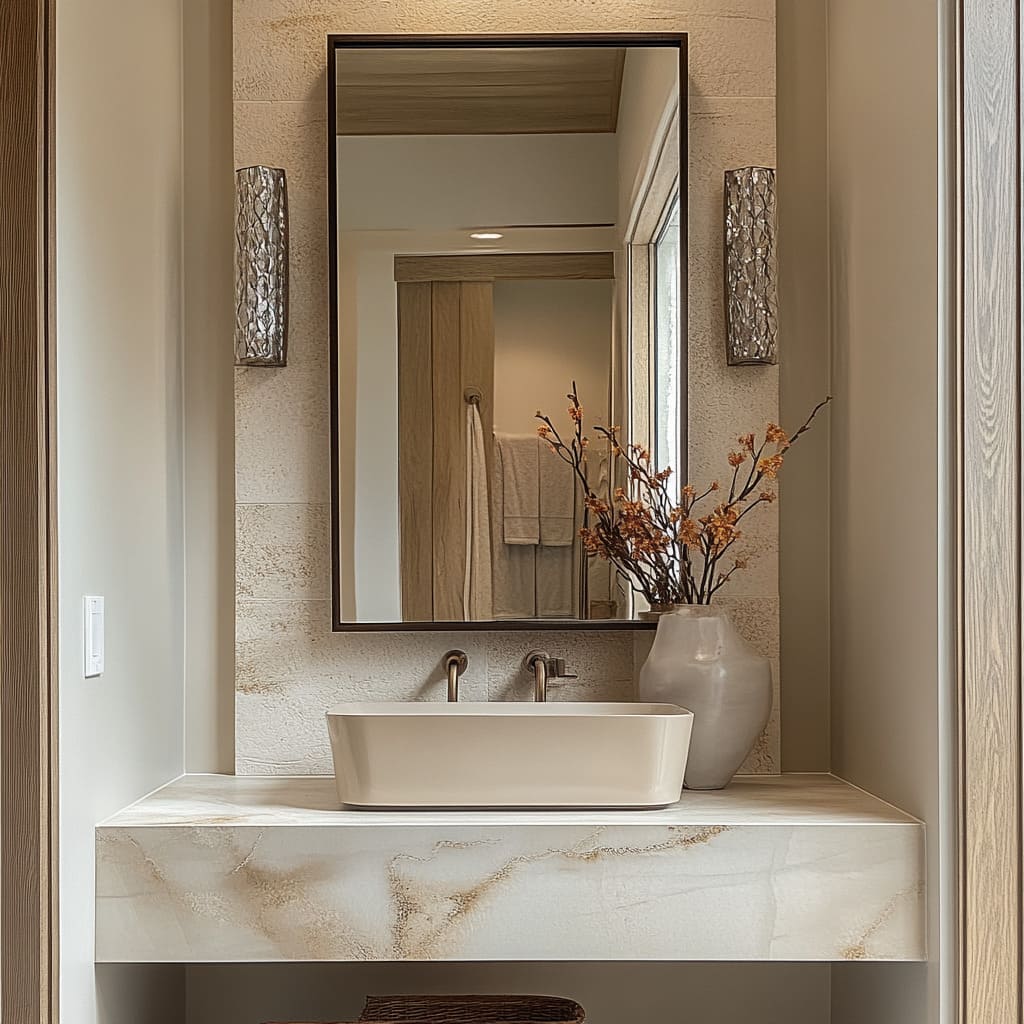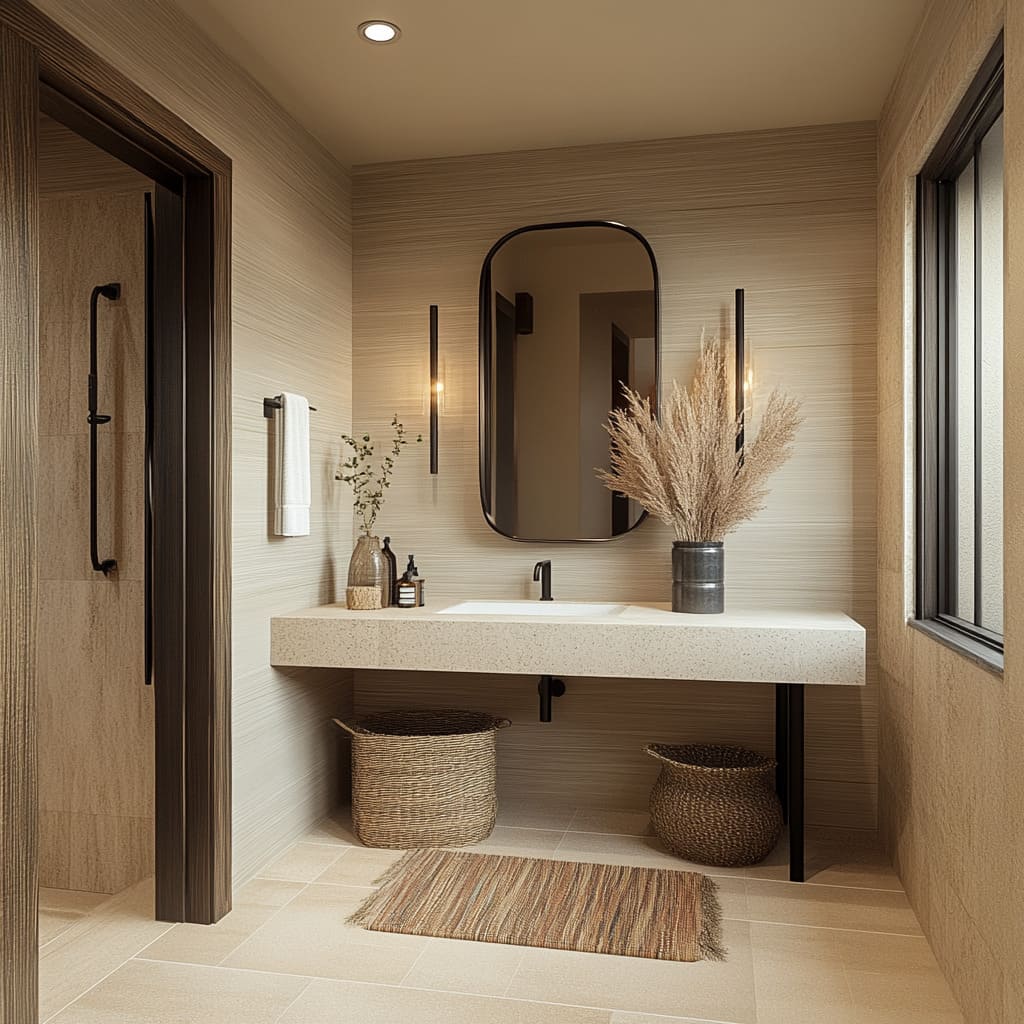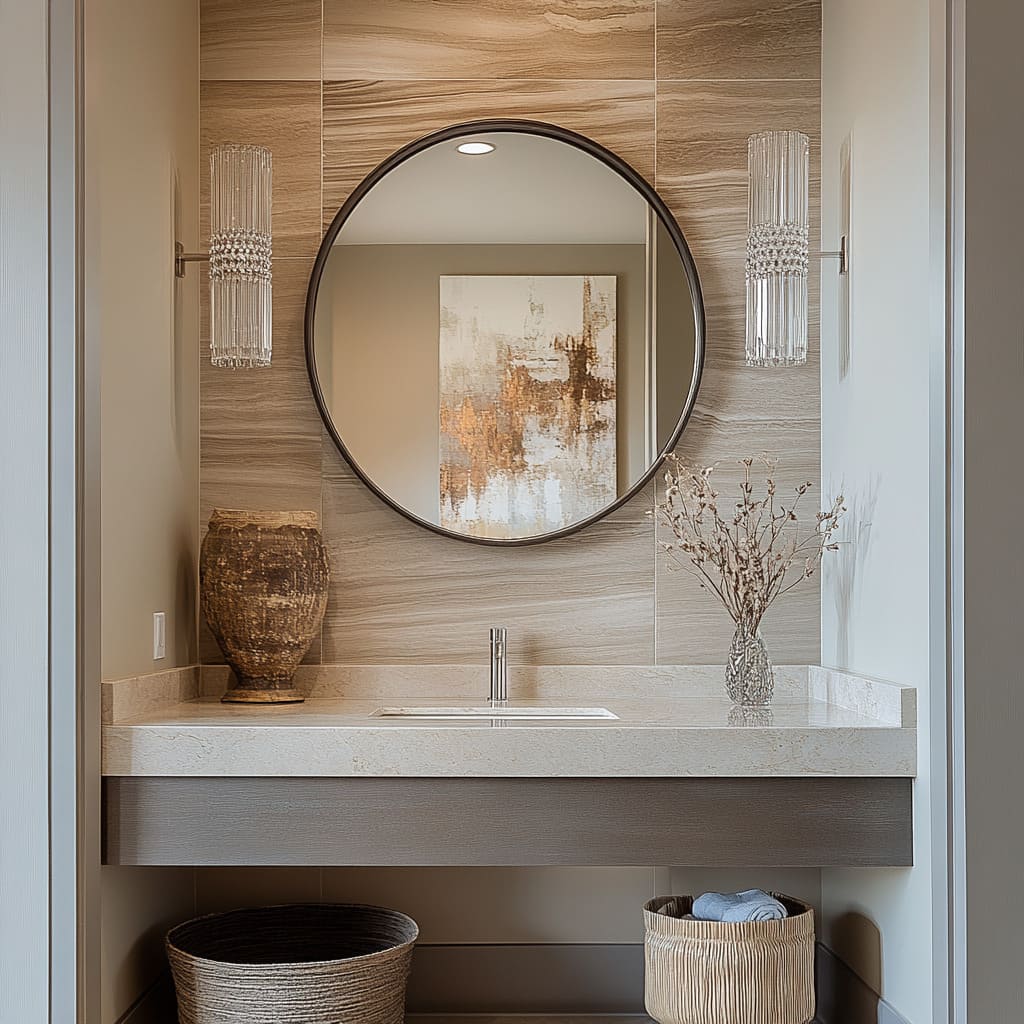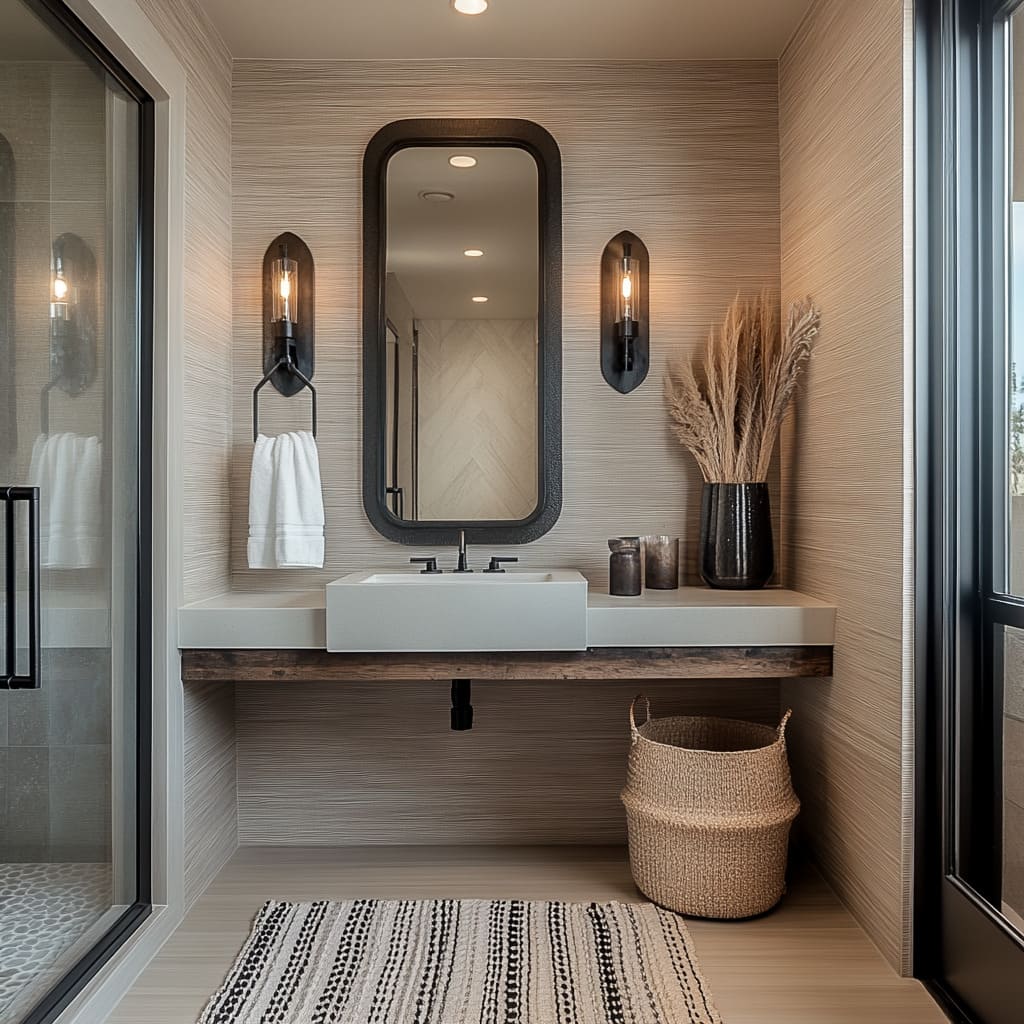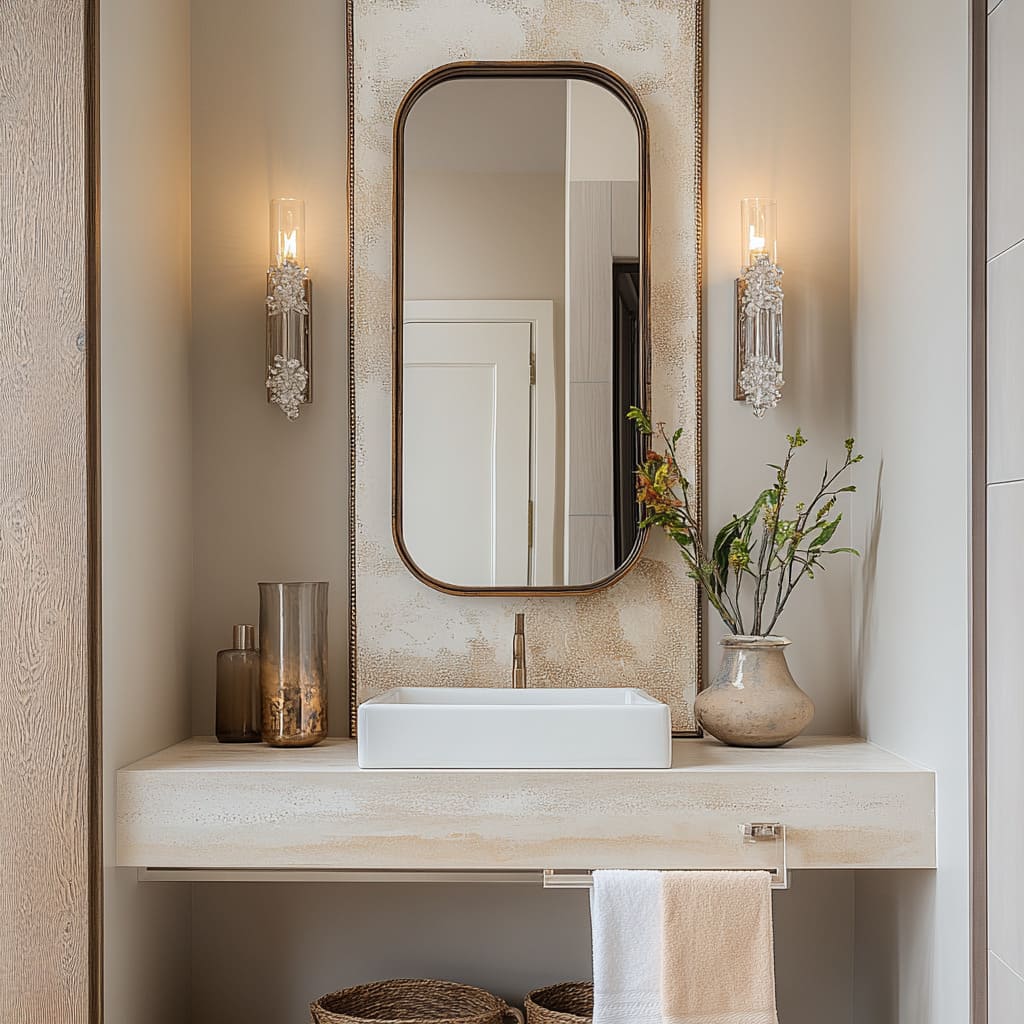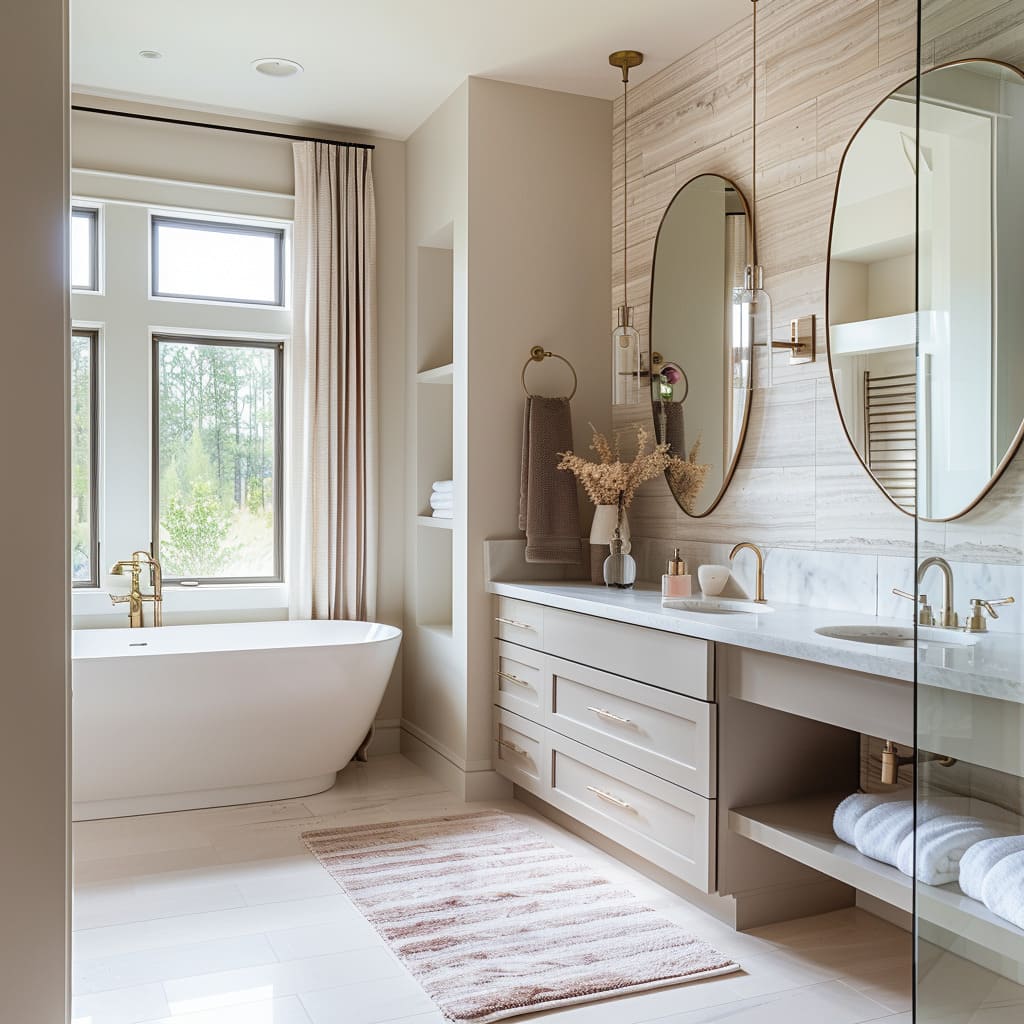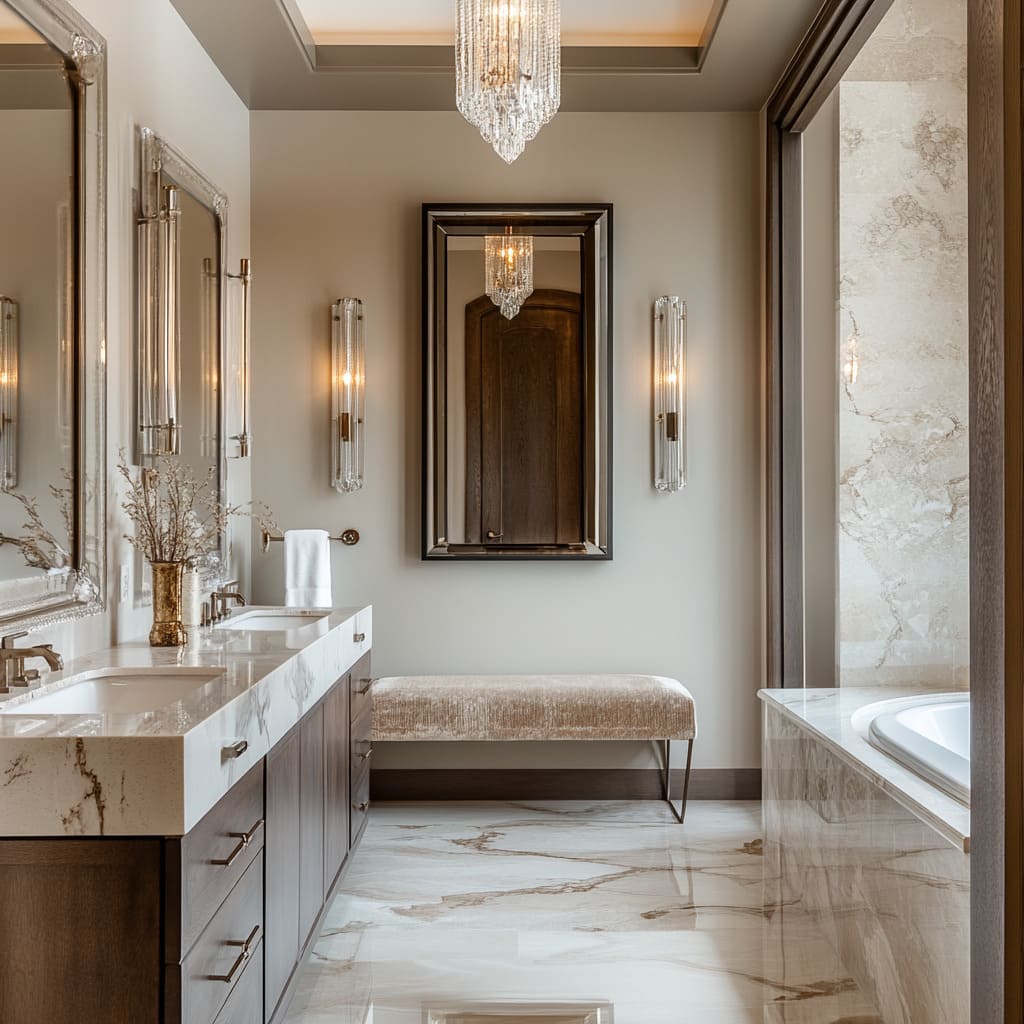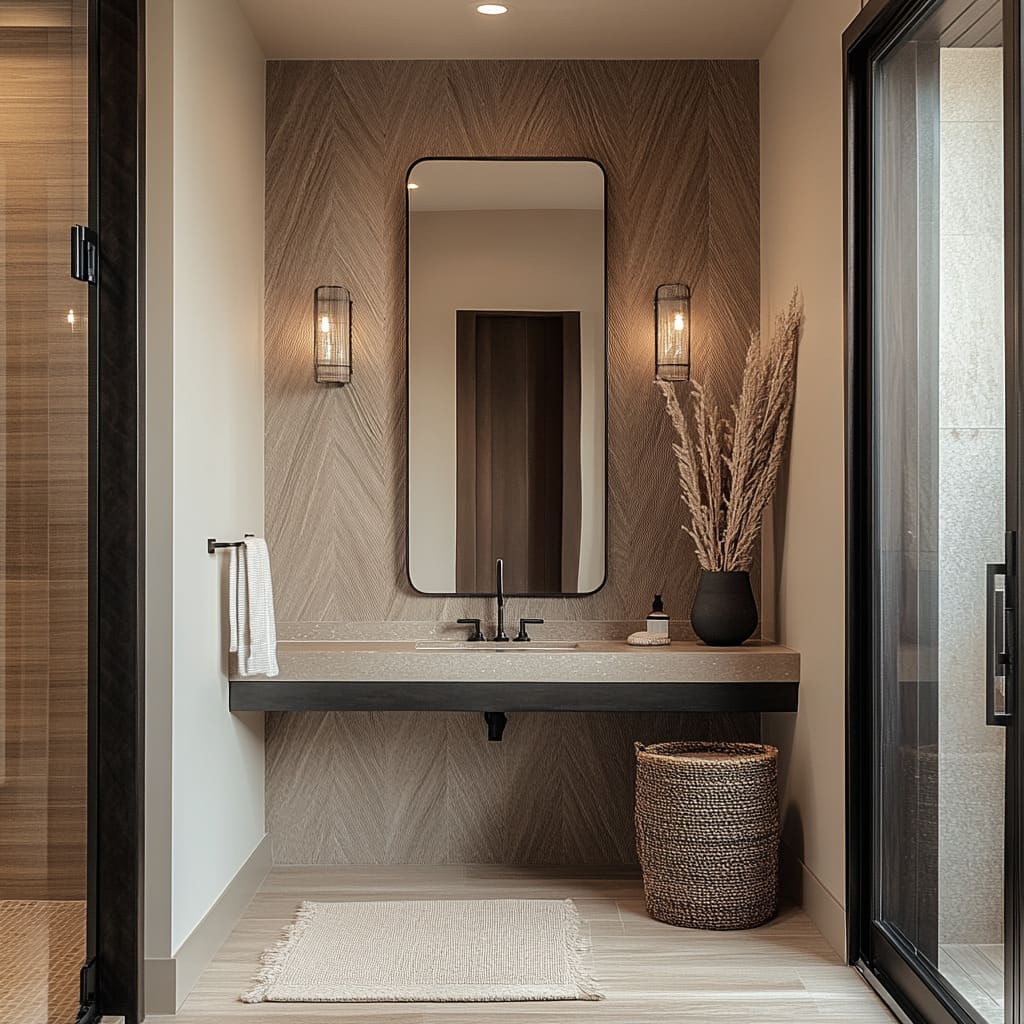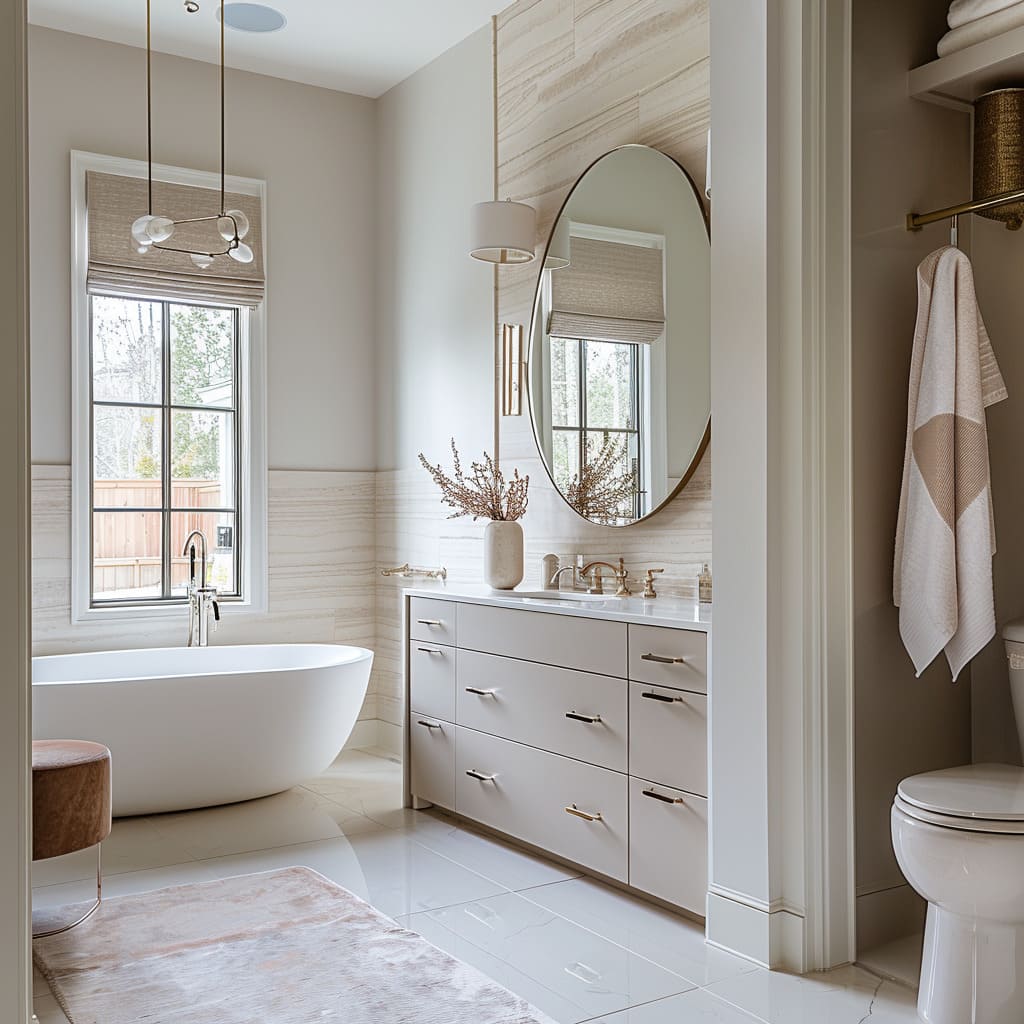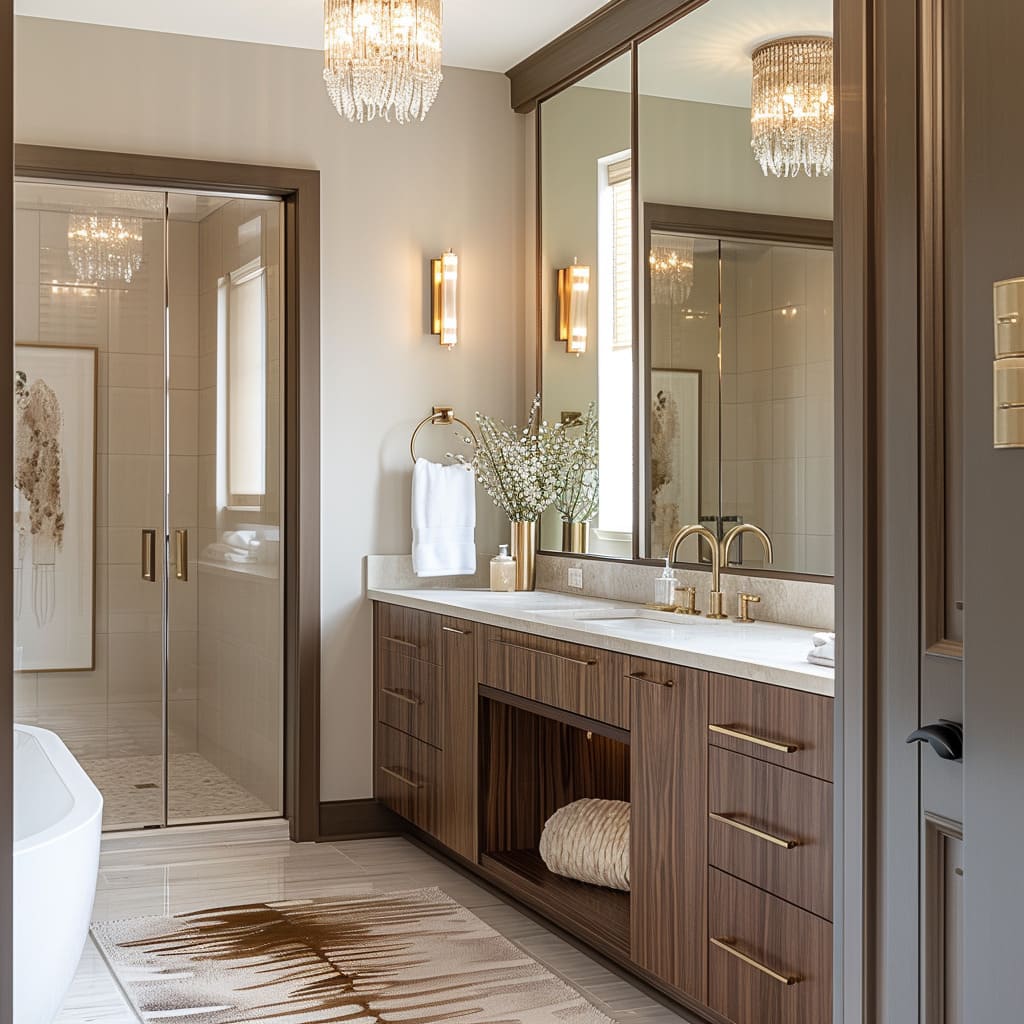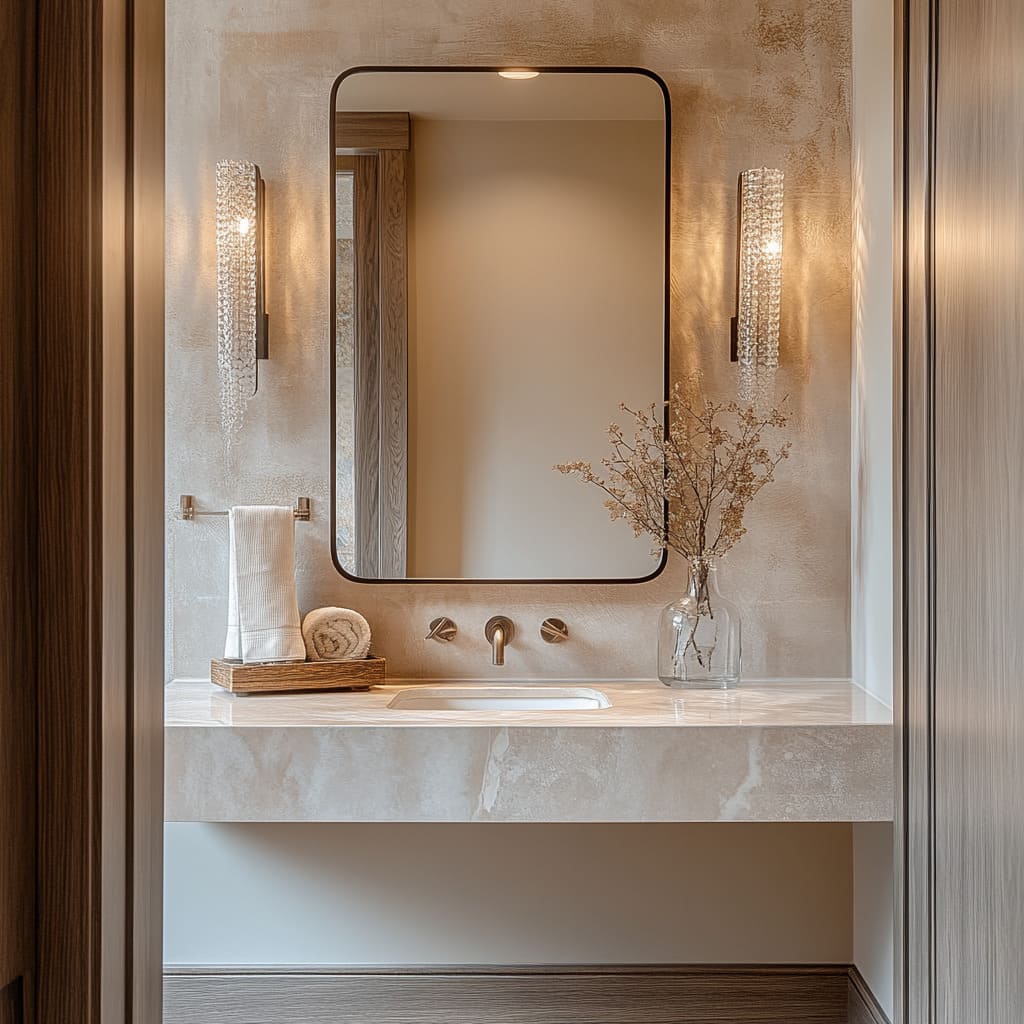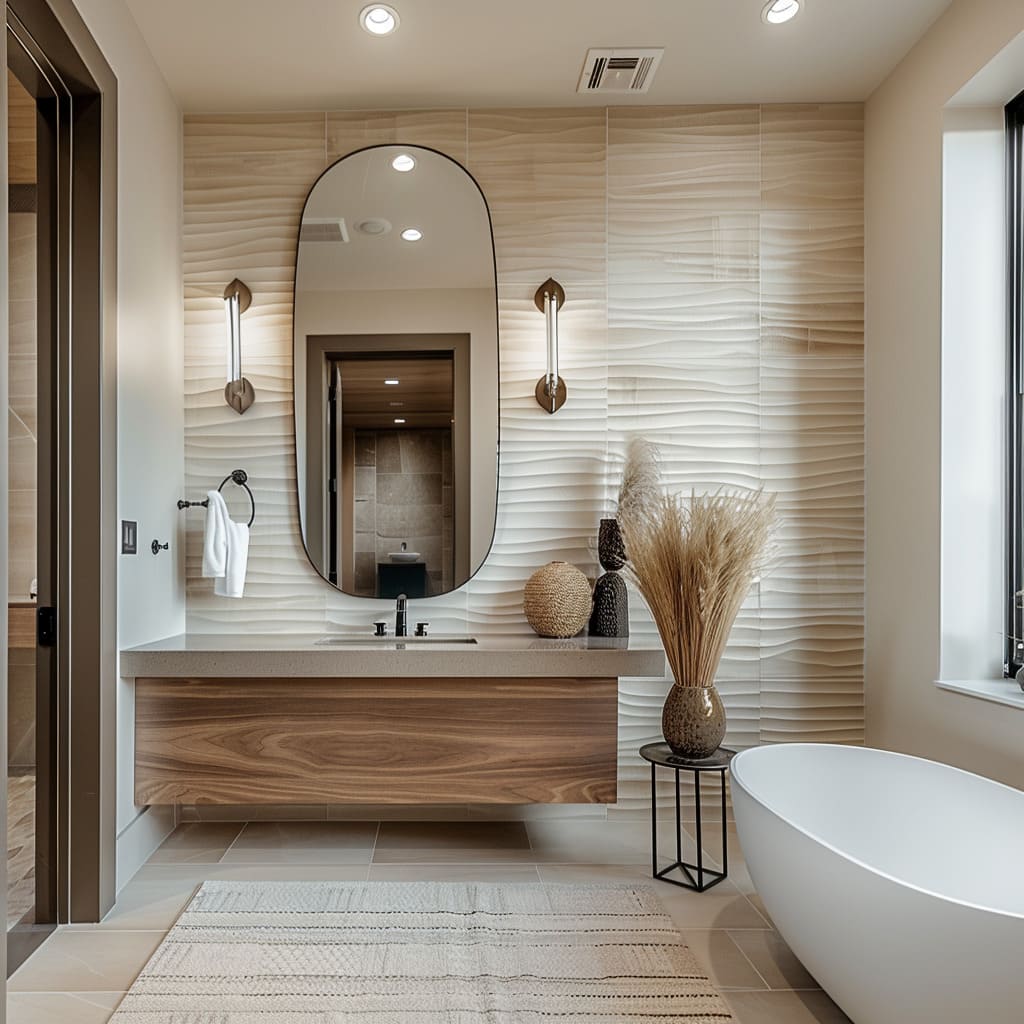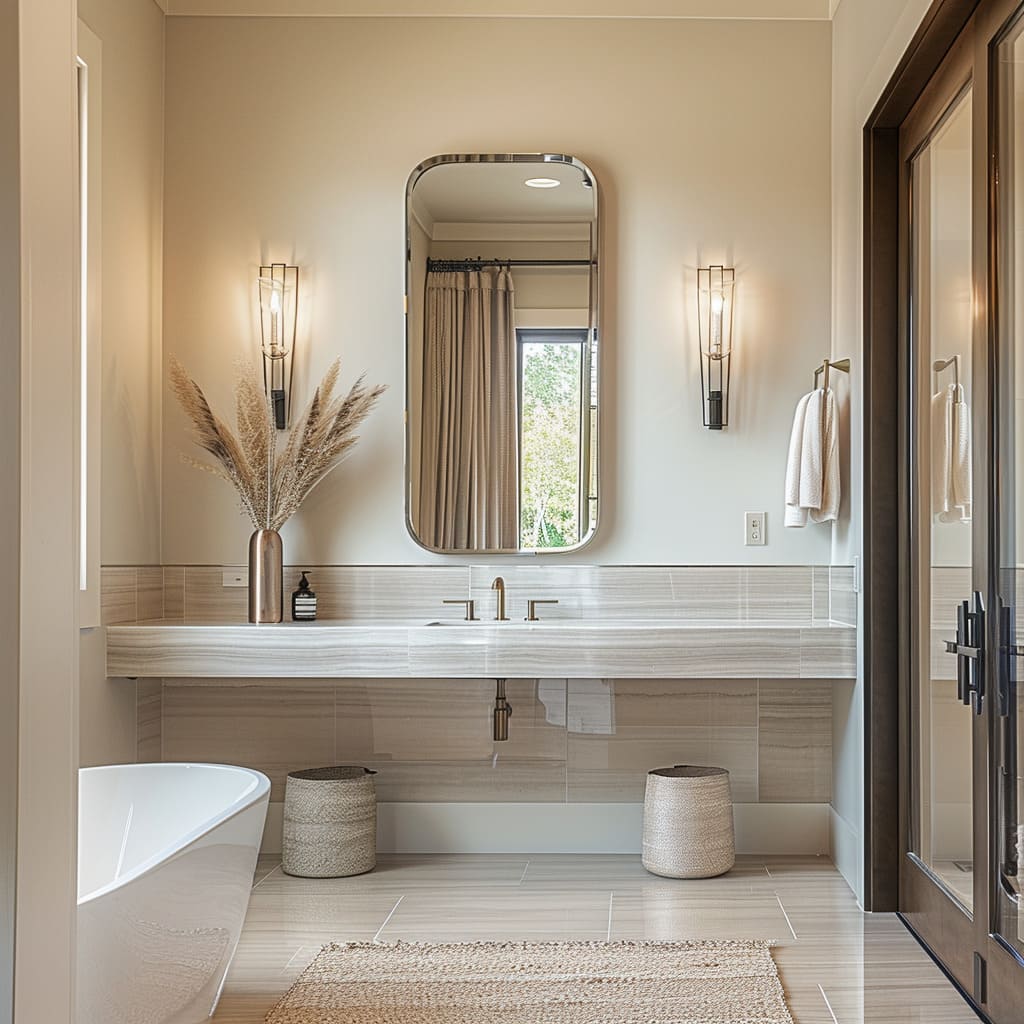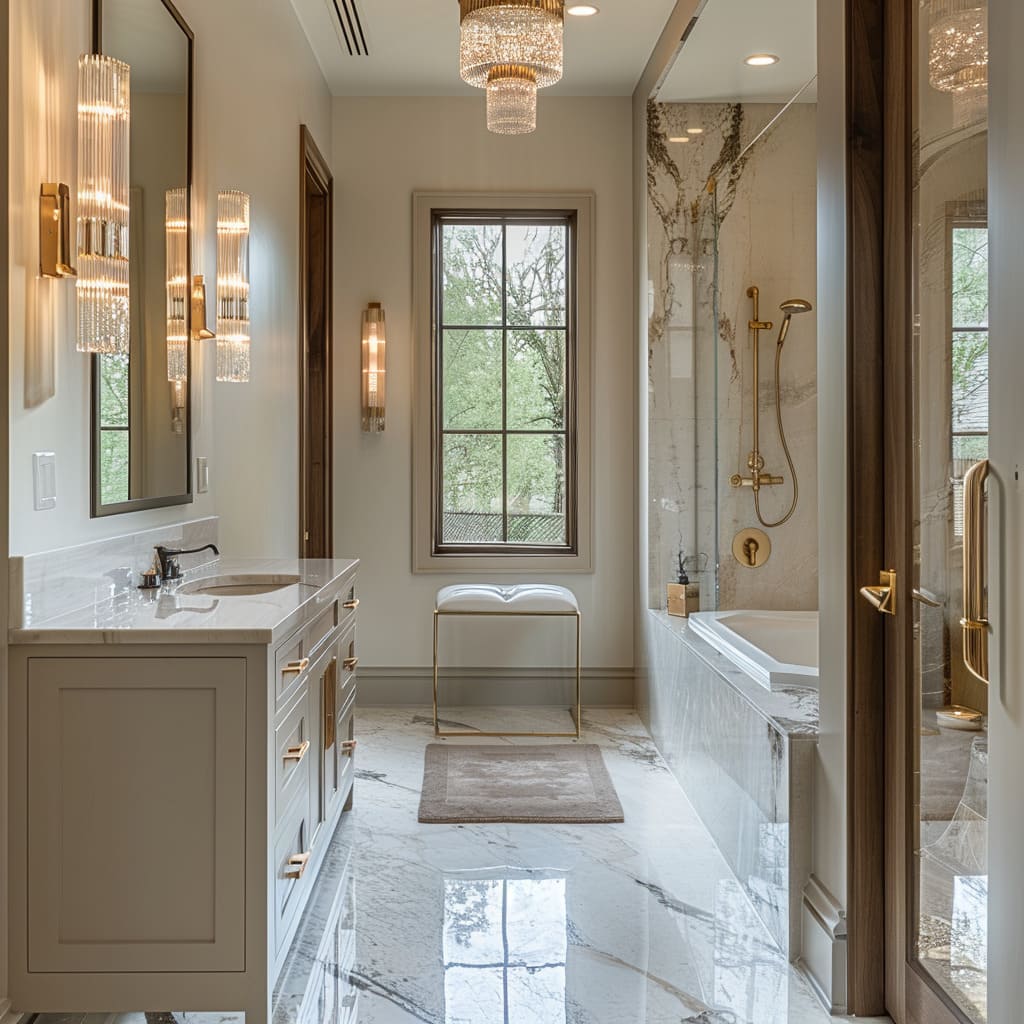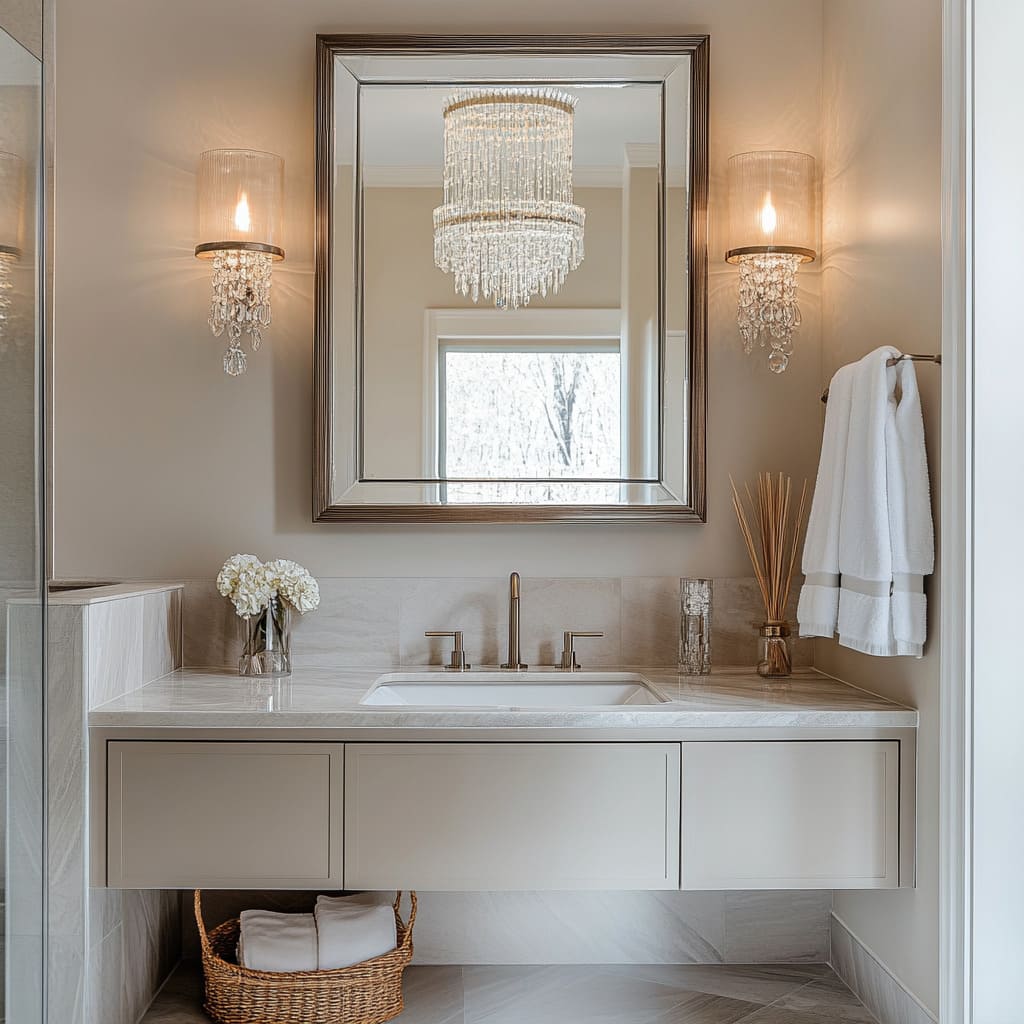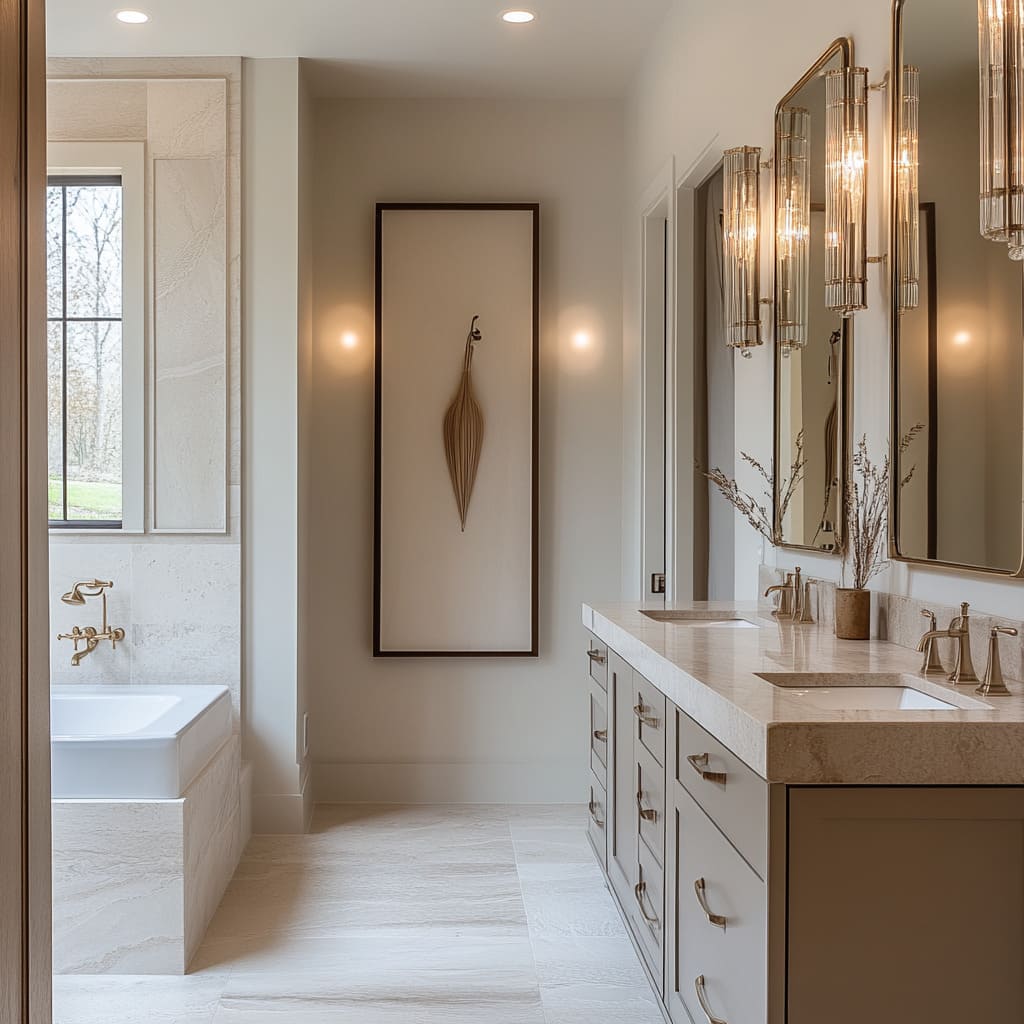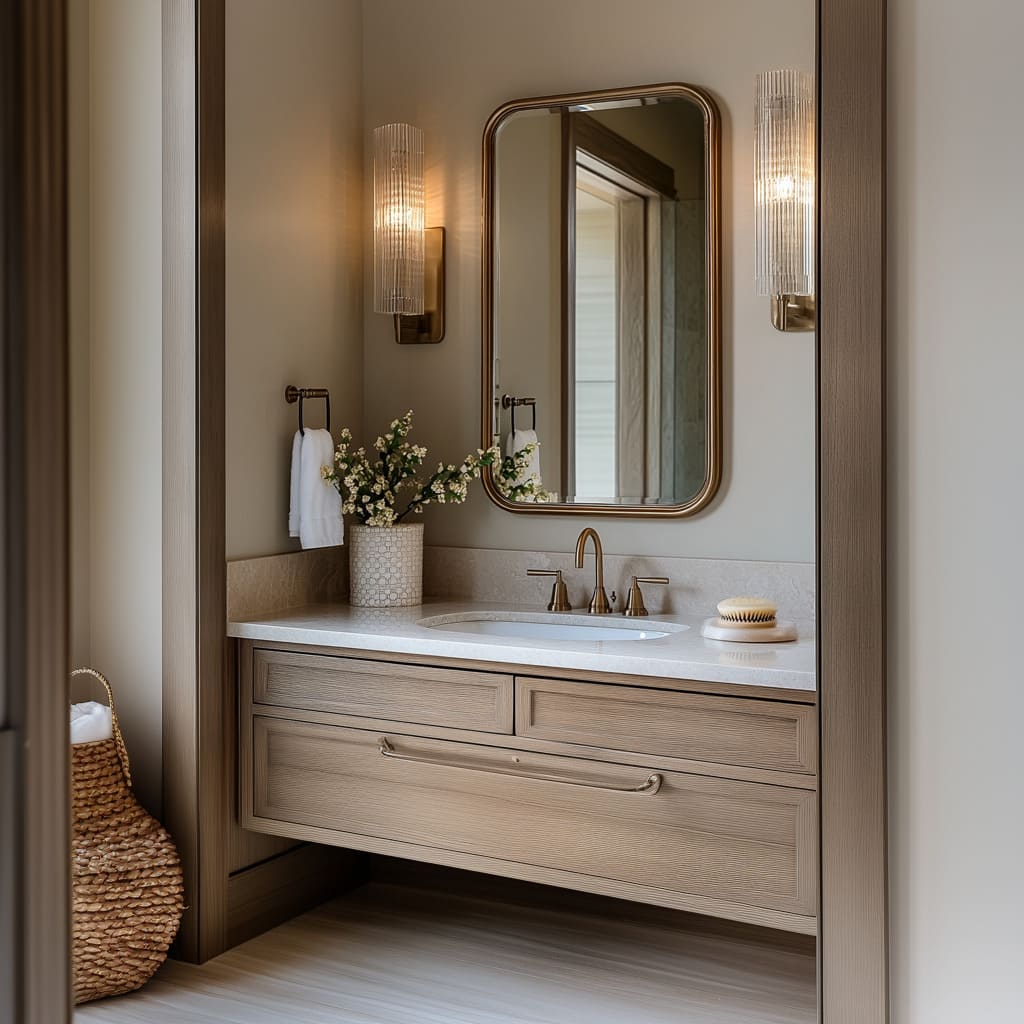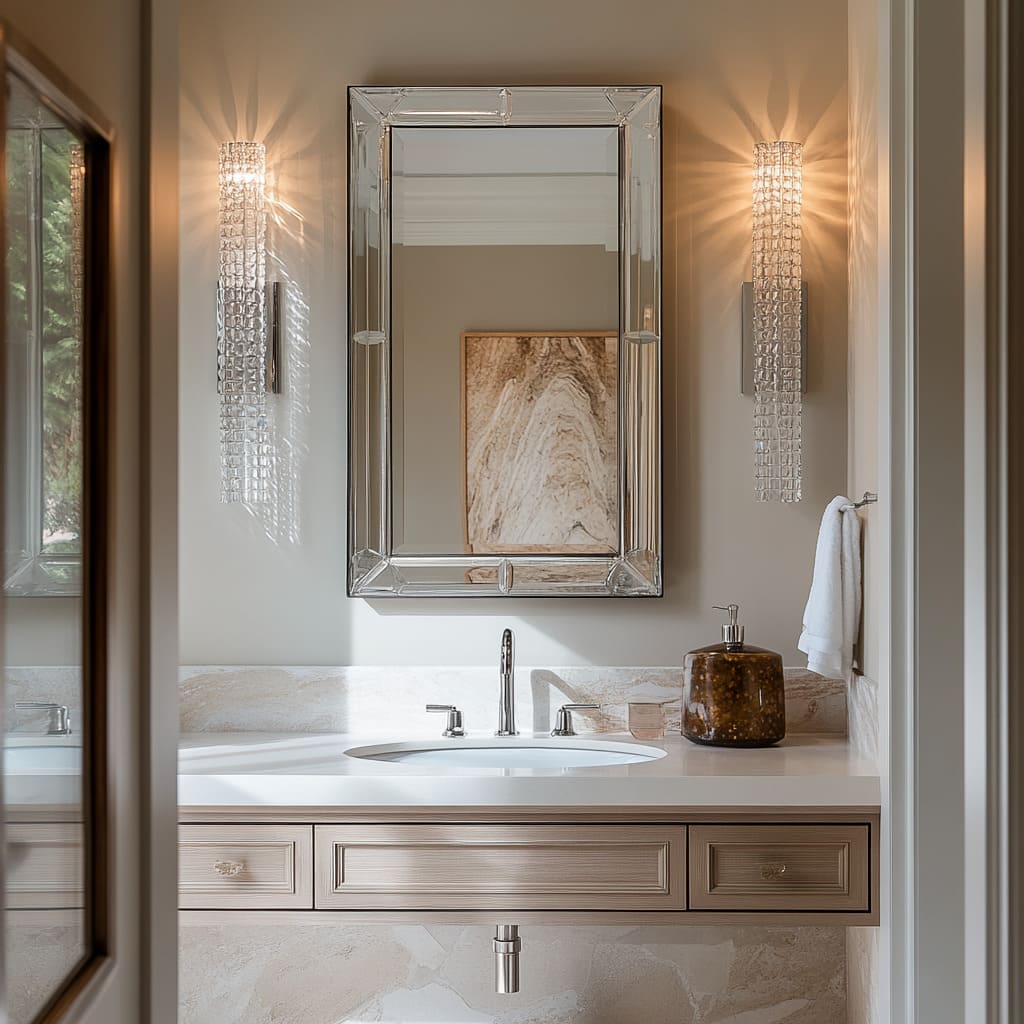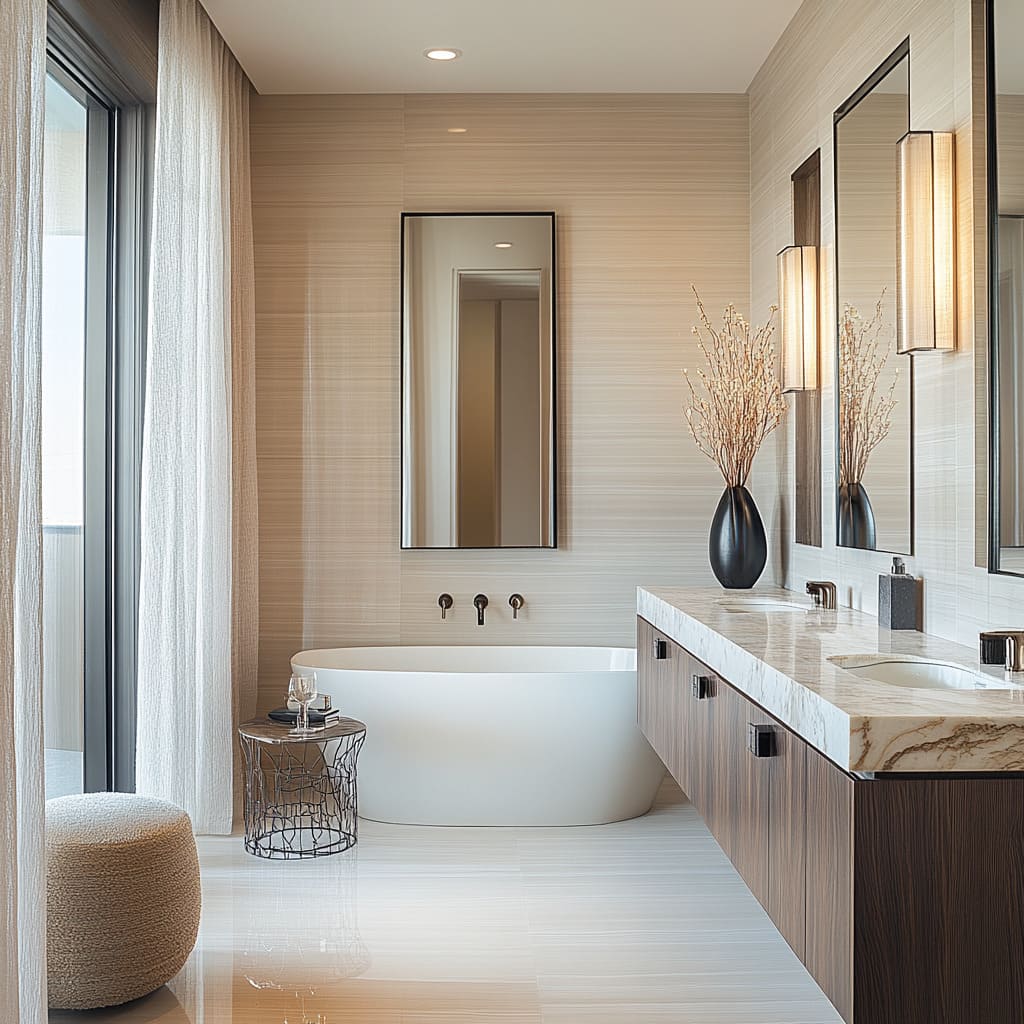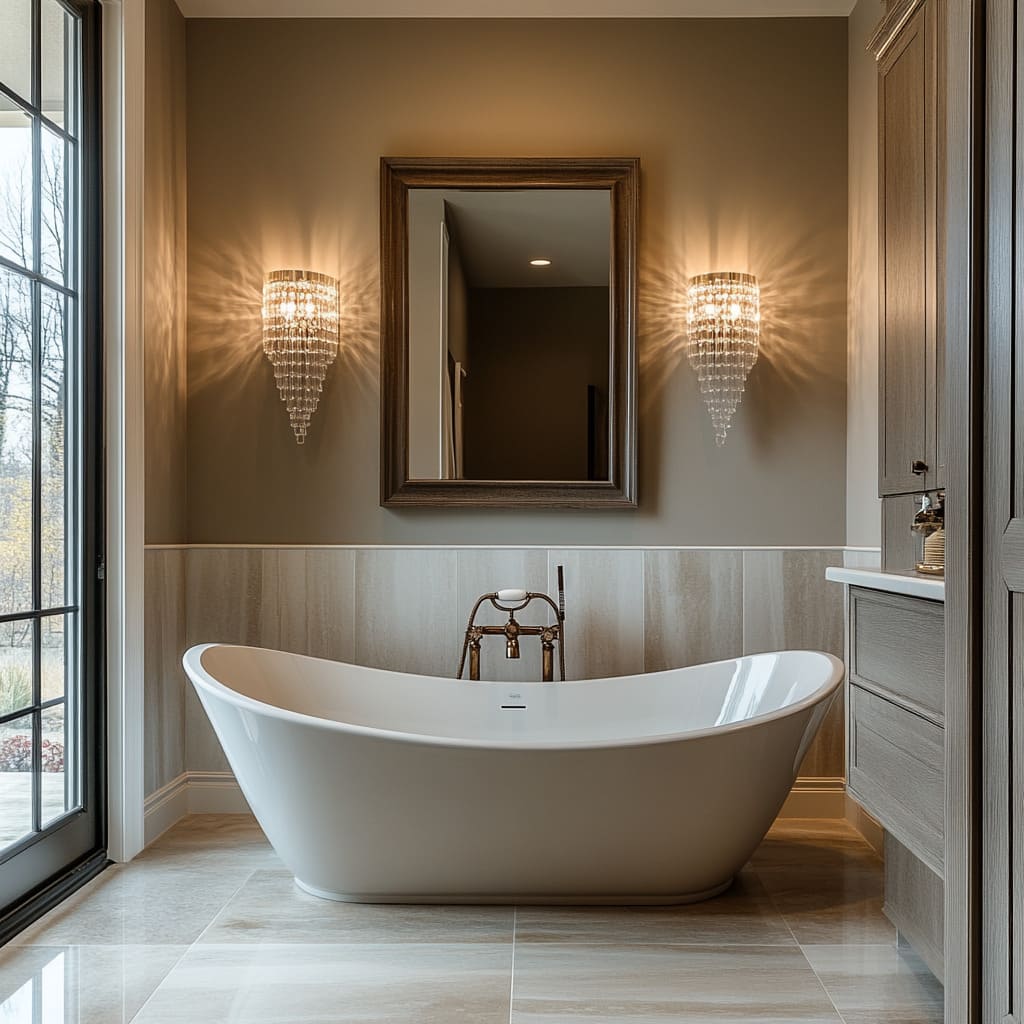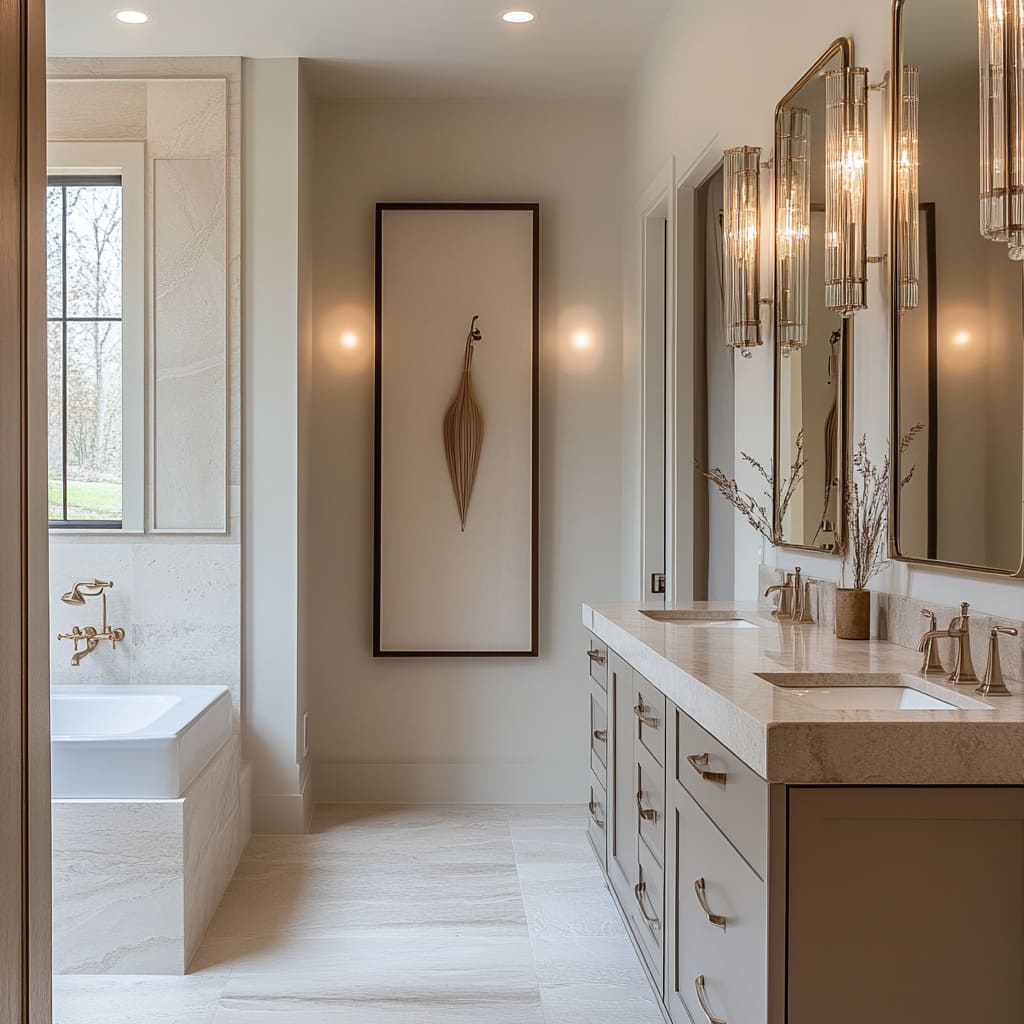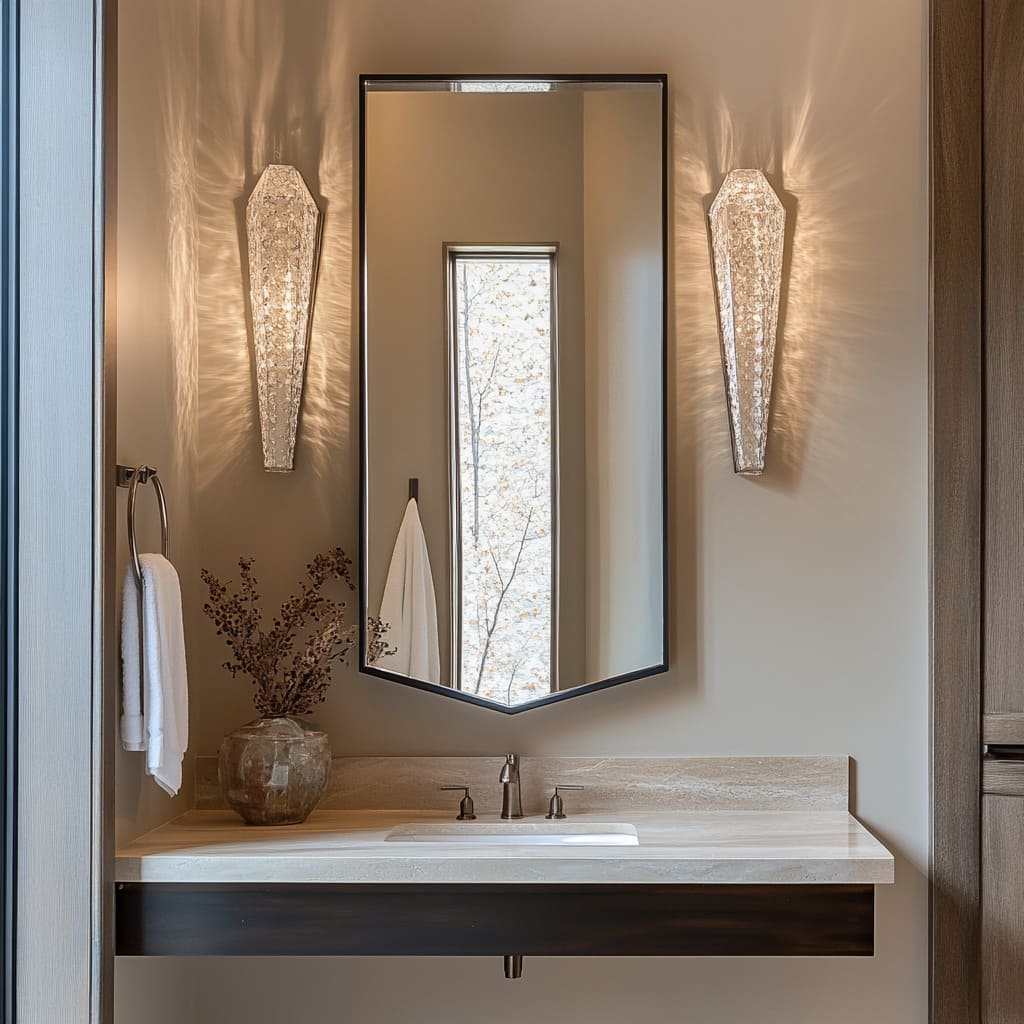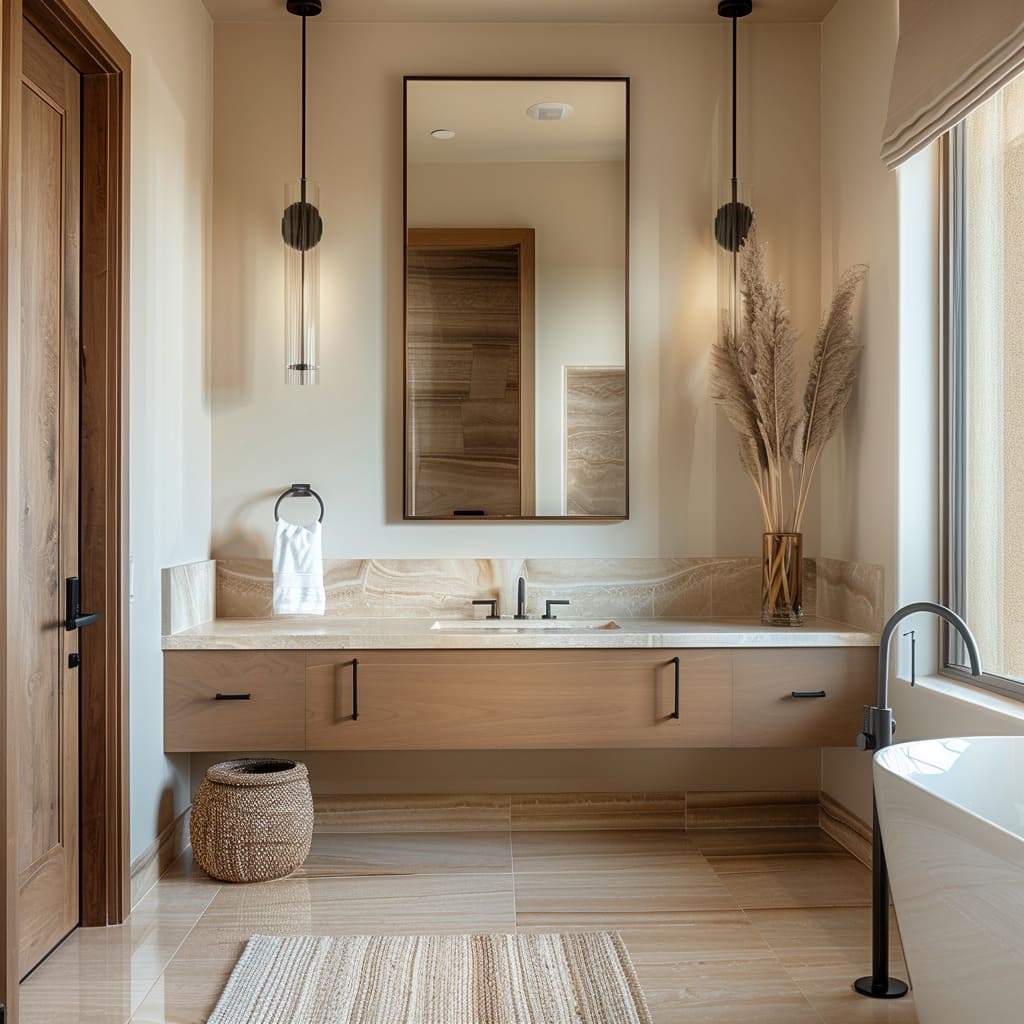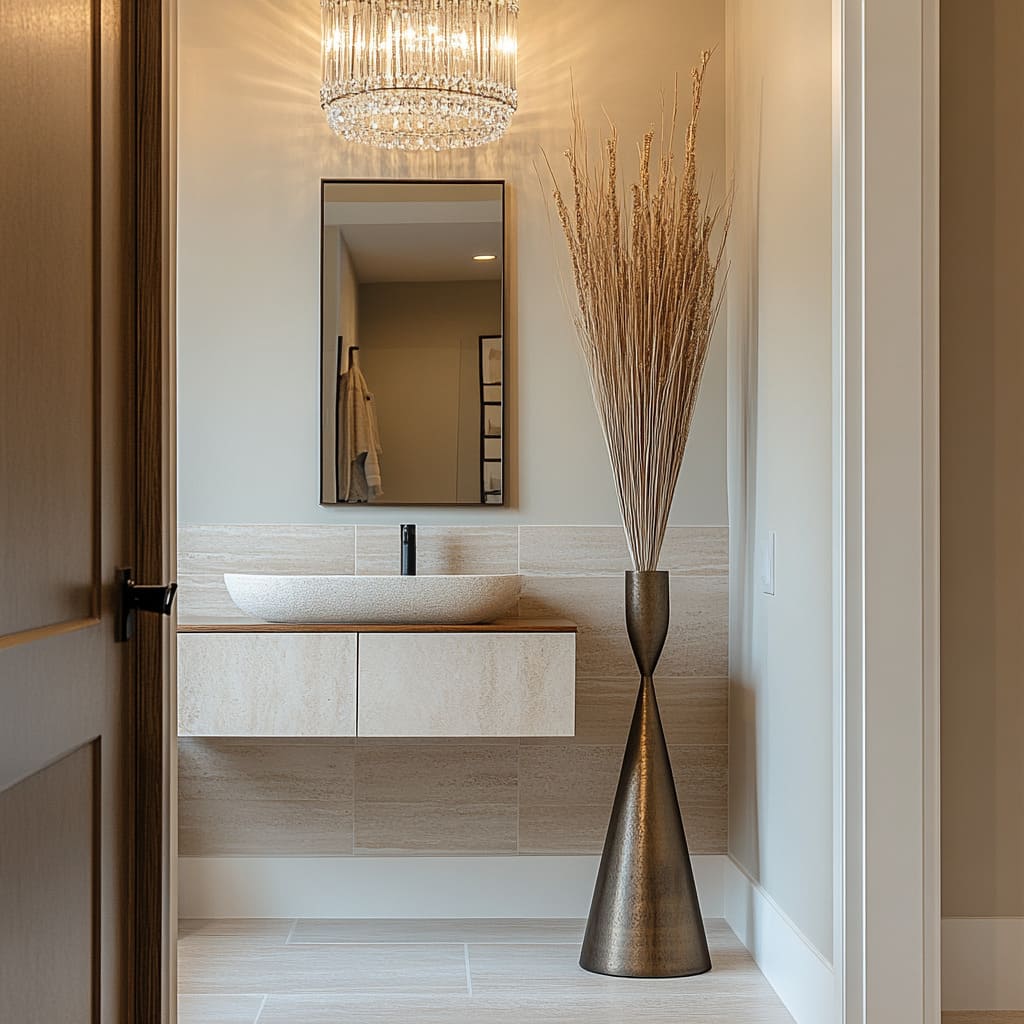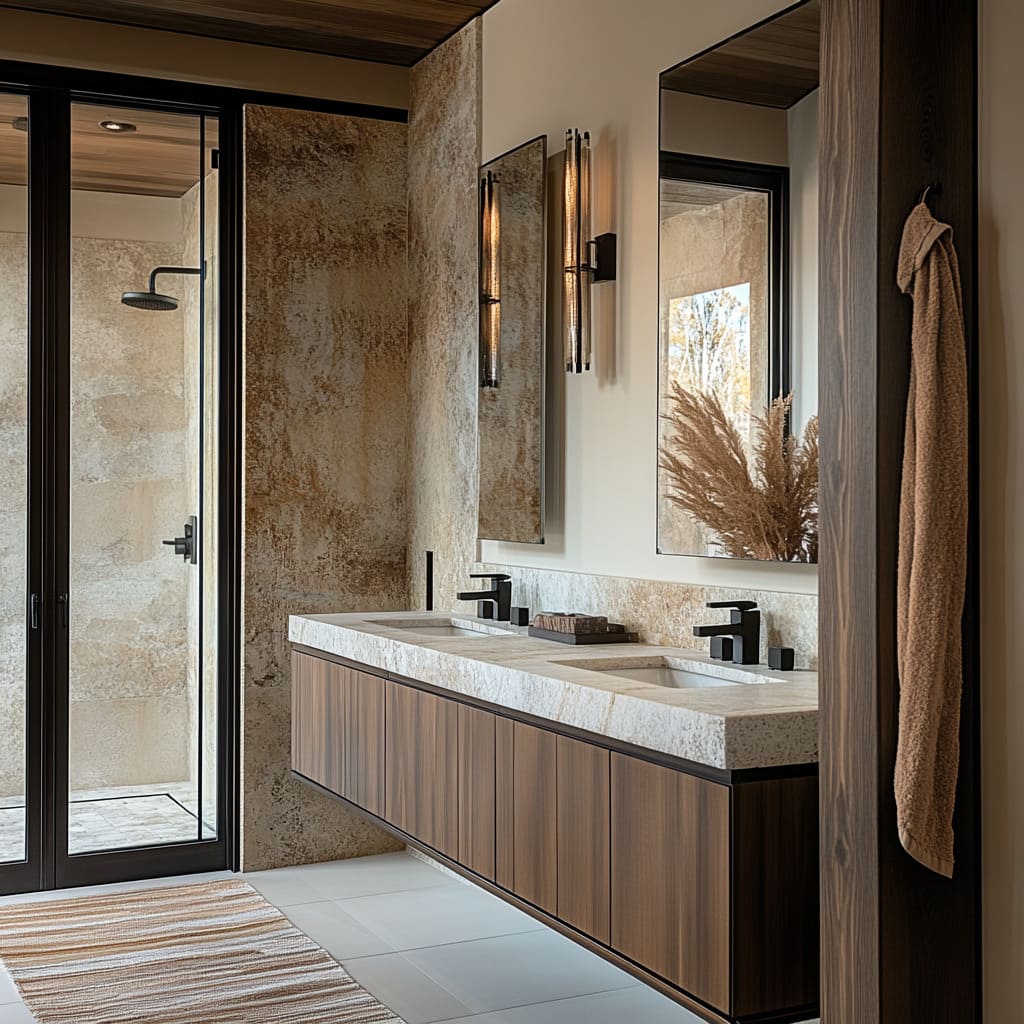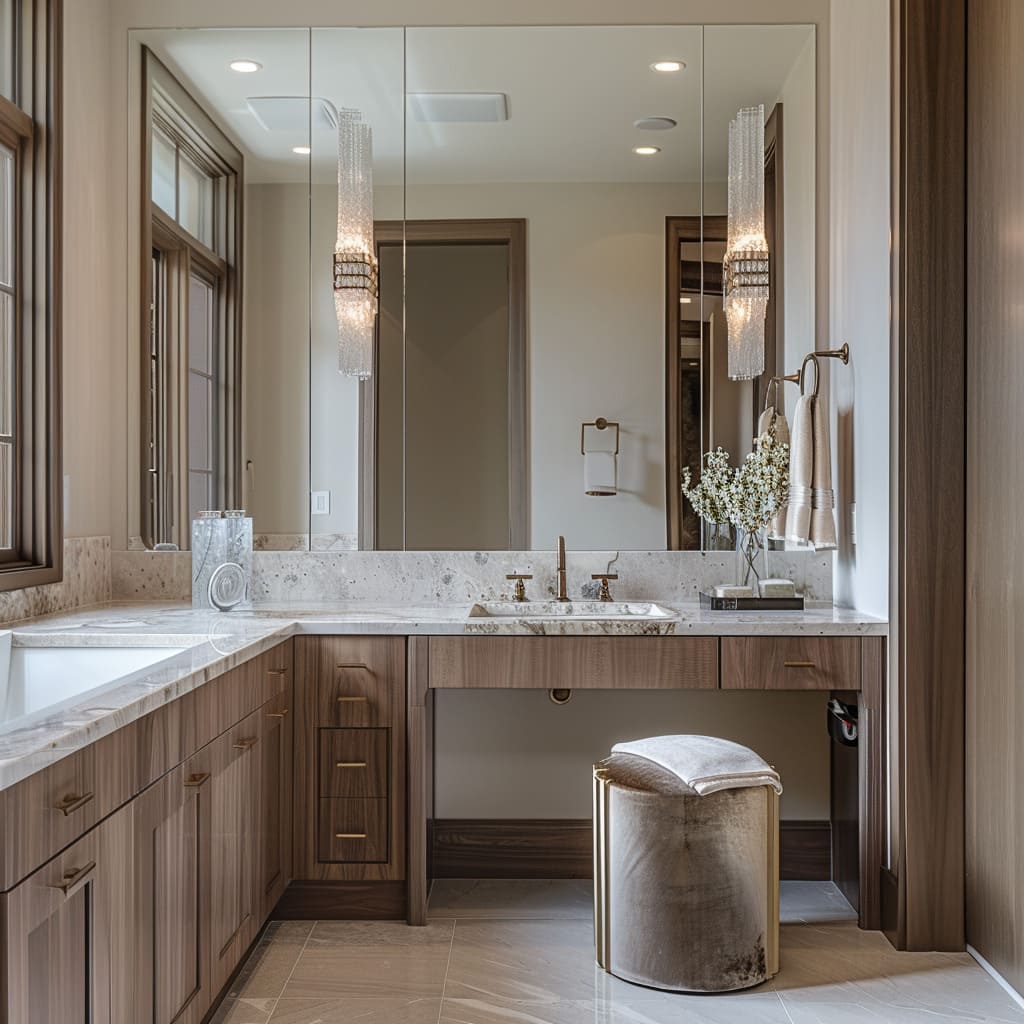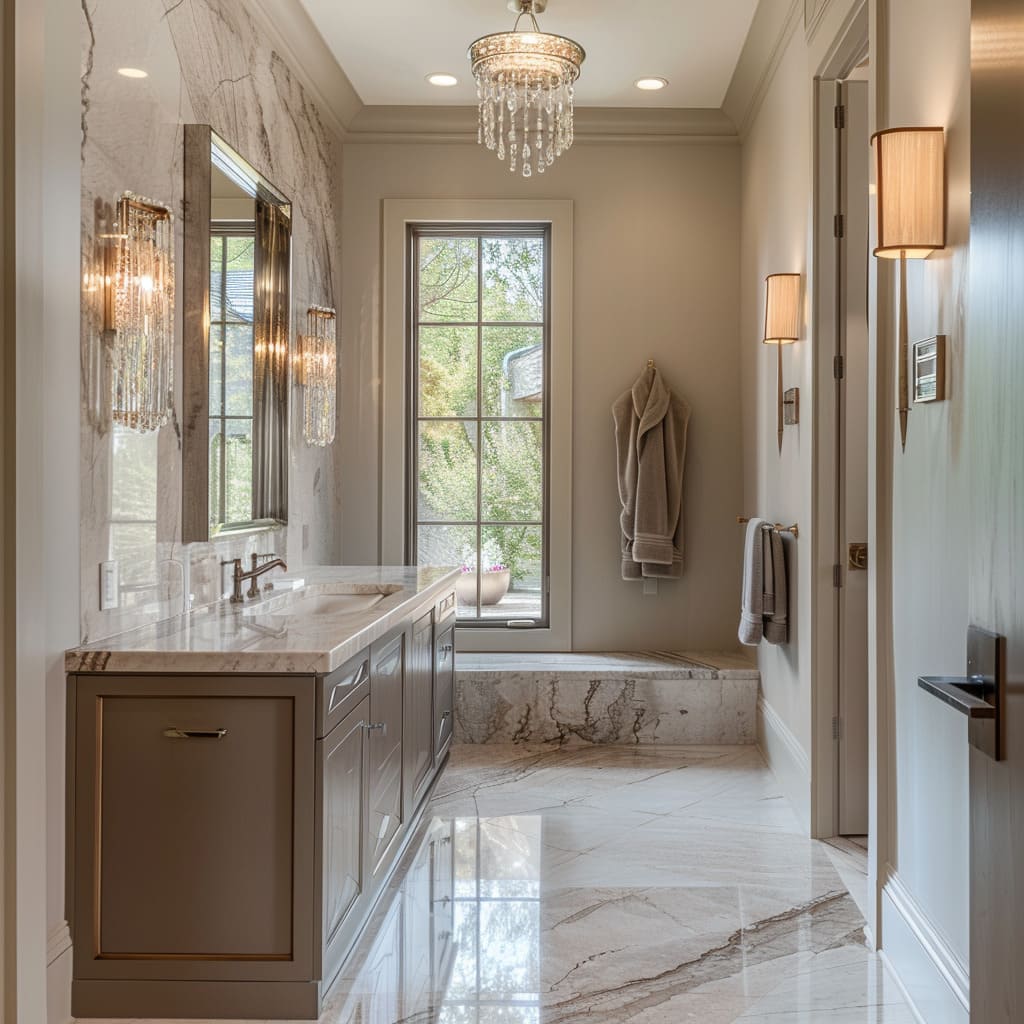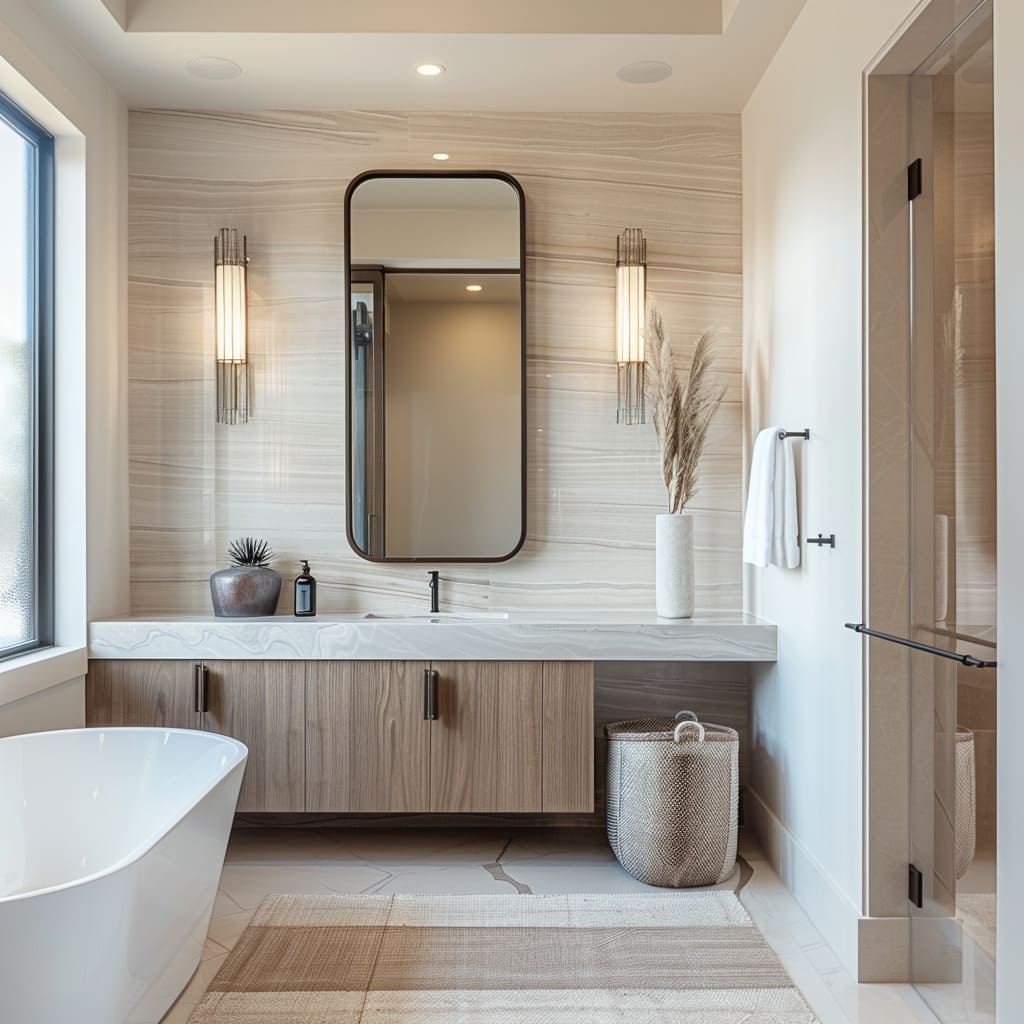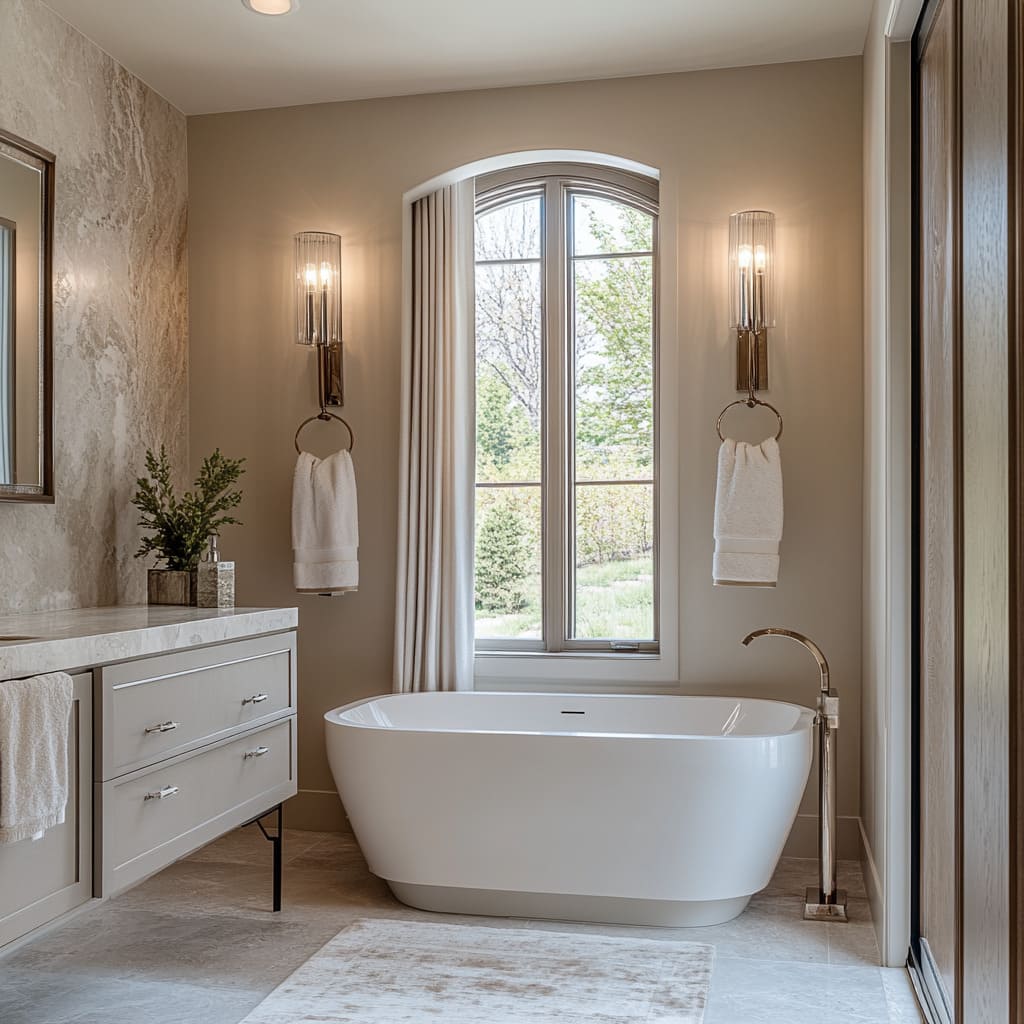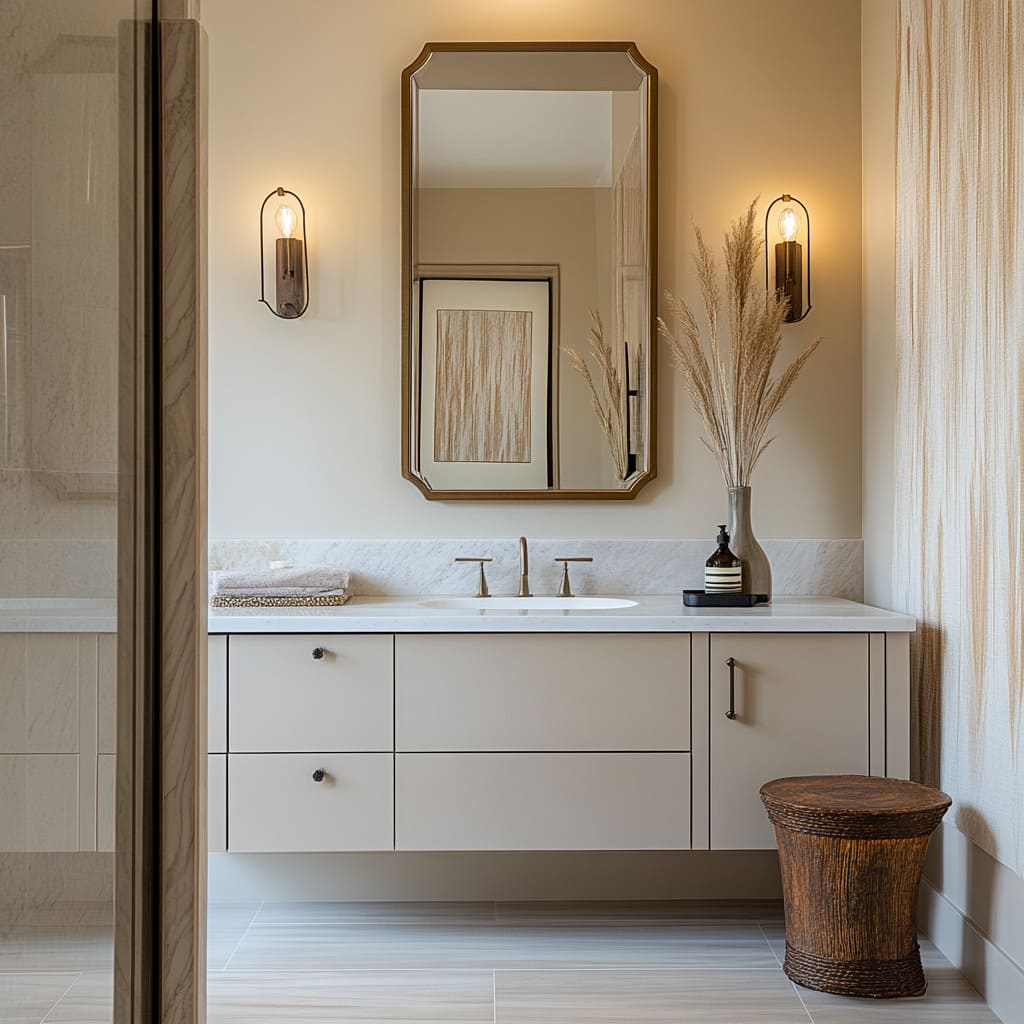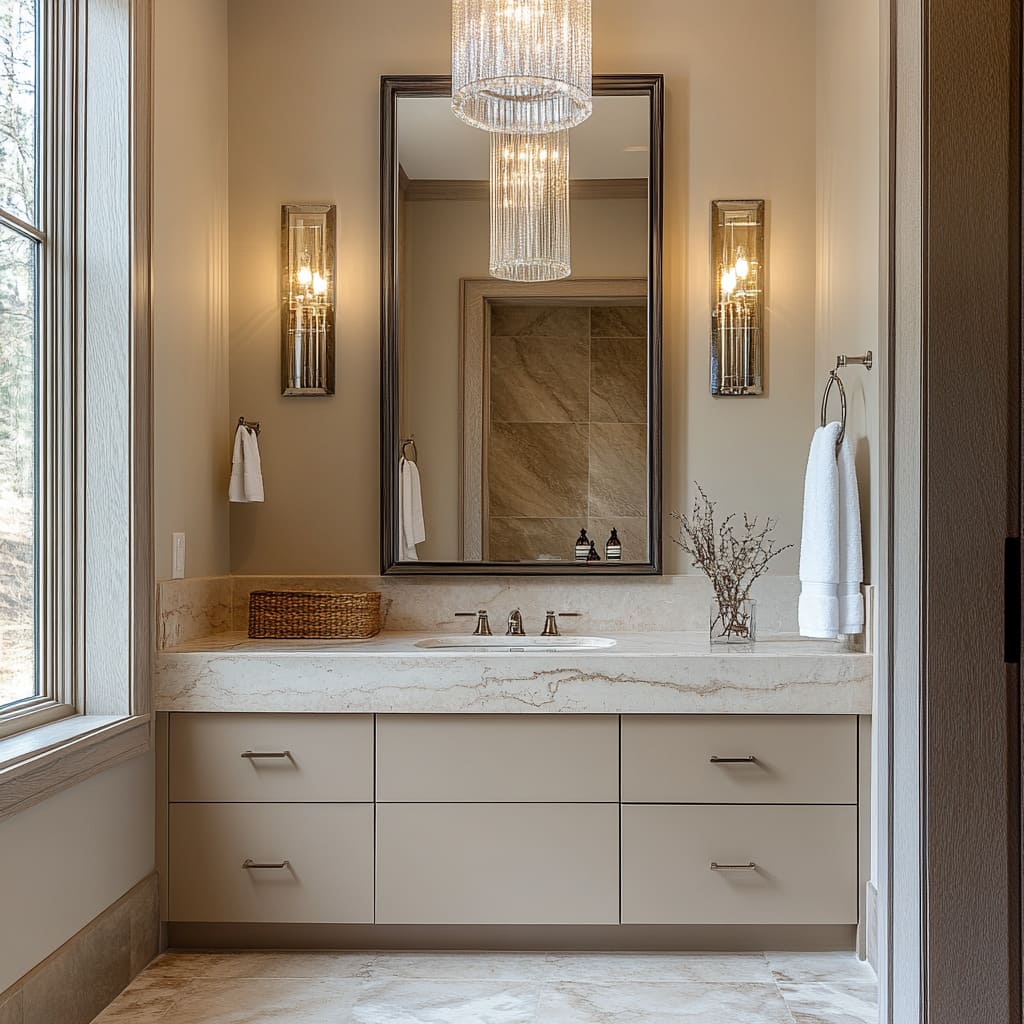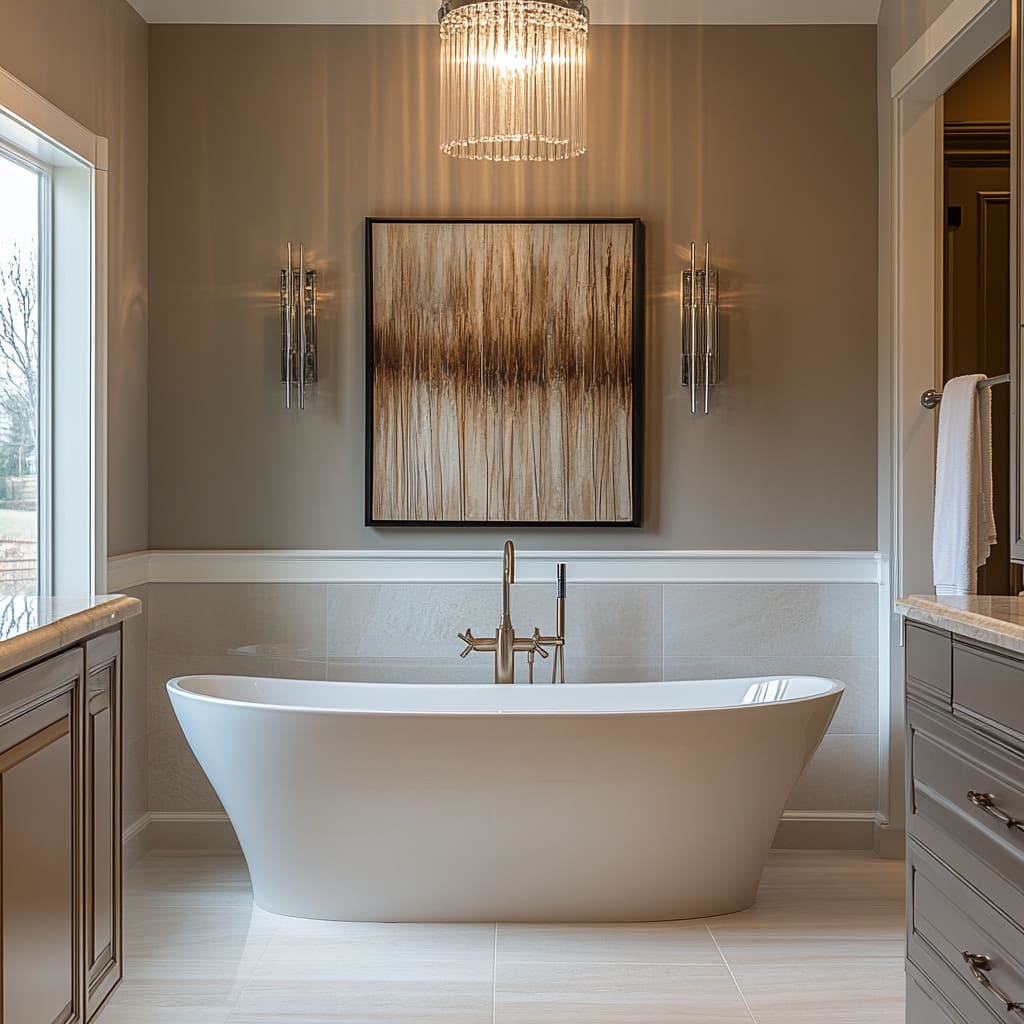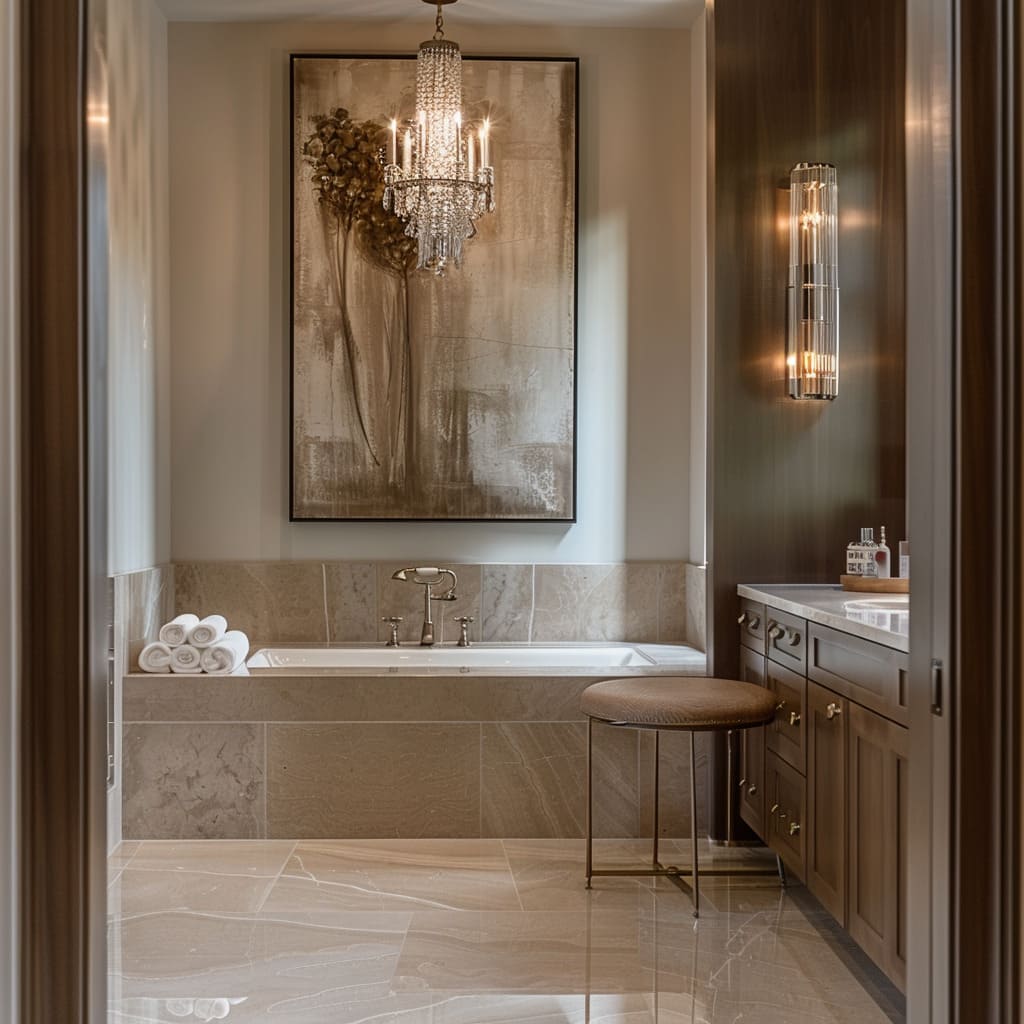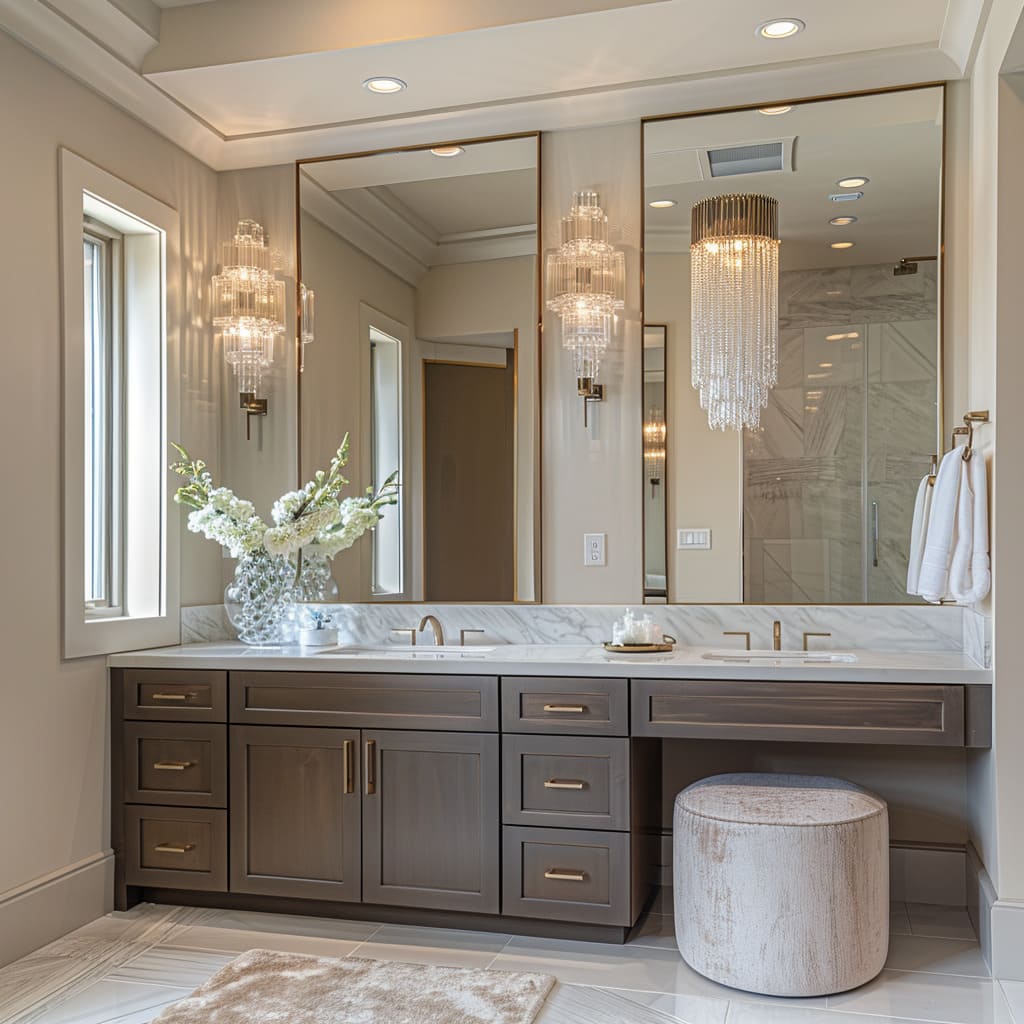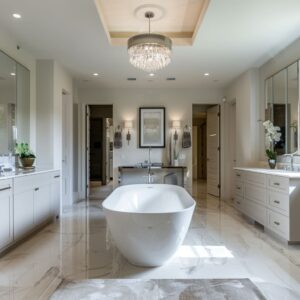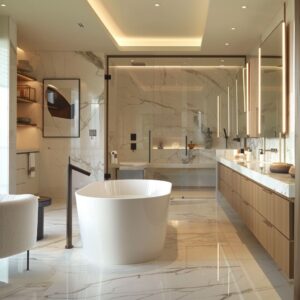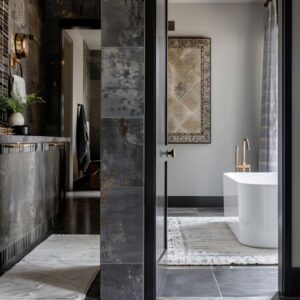Creating a bathroom that stands the test of time involves more than just choosing attractive fixtures and finishes. A timeless bathroom seamlessly blends style with function, ensuring that the space remains relevant and appealing for years to come.
This type of design transcends fleeting trends, offering an environment that feels just as fresh and inviting in a decade as it does today. Achieving this balance requires careful consideration of both modern and classical design elements, each contributing unique qualities that, when combined, result in a space that is both luxurious and enduring.
In this guide, we will explore how to effectively combine modern and classical elements to create a bathroom design that is both timeless and functional. By understanding the characteristics of each style and learning how to integrate them harmoniously, you can develop a bathroom that feels current yet honors traditional aesthetics, making it a true reflection of modern timeless bathroom design
The aim of this article is to provide insights into blending contemporary and traditional design elements to achieve a timeless bathroom. Whether you are looking to update your existing space or planning a complete renovation, these principles will guide you in creating a bathroom that balances modern efficiency with classic beauty.
We will delve into the key aspects of each design approach, offering timeless bathroom ideas that are both practical and visually appealing. This guide is particularly useful for those interested in transitional bathroom design or transitional master bathroom ideas, where the goal is to create a harmonious fusion of old and new
Understanding the Balance Between Modern and Classical Design
The Role of Modern Elements:
Modern design is often characterized by its simplicity, with an emphasis on clean lines, minimalistic details, and the use of advanced materials. In a bathroom, these elements contribute to a sleek, uncluttered look that feels fresh and contemporary.
Key features of modern bathroom design include streamlined vanities, integrated sinks, frameless mirrors, and the use of materials such as glass, metal, and polished stone. These components create a sense of order and openness, making the bathroom not only a functional space but also a visually calm one
Incorporating modern elements into your bathroom can also enhance its functionality. Features like wall-mounted vanities and floating shelves maximize floor space, creating a room that feels more spacious.
Similarly, modern fixtures often come with advanced technology, such as touchless faucets or smart showers, which add convenience and efficiency. By choosing modern elements that prioritize both form and function, you can lay the foundation for a timeless bathroom that remains practical and stylish
The Role of Classical Elements
Classical design elements bring a sense of warmth and tradition to a bathroom, counterbalancing the sometimes stark nature of modern design. These elements might include rich wood finishes, ornate fixtures, and traditional detailing such as crown molding or paneling.
The use of materials like marble or wood adds texture and depth, making the space feel inviting and lived-in. Incorporating classical elements into your bathroom design helps to ground the space, adding a layer of timelessness that is essential for a room meant to endure changing tastes.
For example, a clawfoot tub or a pedestal sink can serve as a striking focal point, while antique-style faucets and lighting fixtures add subtle touches of elegance. These details not only enhance the visual appeal of the bathroom but also connect it to a broader design tradition, making the space feel timeless rather than trendy
Combining these classical elements with modern features creates a transitional bathroom design—a style that marries the best of both worlds. This approach allows you to enjoy the benefits of modern efficiency while preserving the timeless appeal of traditional design.
By carefully balancing these elements, you can create a bathroom that is not only beautiful but also enduring, providing a space that feels comfortable and relevant for years to come
Choosing the Right Color Palette
Neutral Tones and Their Timeless Appeal:
When it comes to achieving a timeless look in your bathroom, the color palette plays a crucial role. Neutral tones such as beige, taupe, and cream are often the foundation of a timeless bathroom design.
These colors create a backdrop that is calm and unobtrusive, allowing other design elements—whether modern or classical—to stand out. Neutral tones are versatile and can be paired with a wide range of materials and finishes, making them an ideal choice for a bathroom that needs to remain stylish over time
A neutral color palette also enhances the sense of space in a bathroom, especially when combined with natural light. Light-colored walls, floors, and fixtures reflect more light, making the room feel larger and more open.
This is particularly important in smaller bathrooms where space is at a premium. By choosing neutral tones as your base, you can create a bathroom that feels fresh, clean, and timeless
Integrating Contrasting Colors:
While neutral tones provide the foundation for a timeless bathroom, introducing contrasting colors can add depth and interest to the design. Darker wood tones, matte black fixtures, or rich bronze accents can be used sparingly to create focal points and draw the eye.
These contrasting elements should be carefully balanced to avoid overwhelming the space. For example, a dark wood vanity can anchor the room, while matte black faucets add a modern edge without overpowering the overall design
The key to integrating contrasting colors is balance. Too much contrast can disrupt the harmony of the space, making it feel disjointed.
However, when done correctly, these elements can enhance the timeless quality of the bathroom by adding visual interest and preventing the design from feeling too flat or monotonous. By carefully selecting where and how to introduce contrast, you can create a bathroom that is both dynamic and enduring
Find Out What Your Budget Can Cover for a Bathroom Update
Wondering what your budget can handle? From a simple freshening up to a high-end remodel for a spa-like feel, our calculator shows you the possibilities.
[budget_renovation_calculator]
Vanity and Countertop Design
Modern Vanity Designs
Modern vanity designs are all about simplicity, functionality, and a sleek appearance. A popular choice in contemporary bathrooms is the floating vanity, which is mounted directly onto the wall rather than sitting on the floor.
This design creates a sense of spaciousness by leaving the floor area beneath the vanity visible, making the room feel larger and more open. Floating vanities often feature clean lines and a minimalist aesthetic, with flat-panel doors and drawers that lack handles or knobs.
This handle-less design contributes to a streamlined, uncluttered look that is central to achieving a timeless bathroom design
The appeal of modern vanities lies in their versatility and the ability to blend seamlessly with various styles, from ultra-modern to more transitional style bathroom settings. Their minimalist design emphasizes functionality while providing ample storage space to keep the bathroom tidy and organized.
Modern vanities often incorporate materials like glass, high-gloss lacquer, and metal, which contribute to their sleek appearance. The use of these materials also adds a contemporary edge to the space without making it feel cold or impersonal.
The key to a modern yet timeless look is the restraint shown in the design choices—avoiding excessive ornamentation and focusing on the purity of form and function
Classical Vanity Elements
While modern vanity designs focus on simplicity and minimalism, classical vanity elements bring warmth and a touch of tradition to the bathroom. Rich wood finishes, traditional cabinetry styles, and detailed craftsmanship are hallmarks of a more classic approach.
These vanities often feature panelled doors, decorative moldings, and brass or bronze hardware, which add depth and character to the bathroom. Incorporating these classical elements into the vanity design can help create a balanced, transitional bathroom idea that merges the best of both worlds
The balance between modern minimalism and classical warmth is key in designing a vanity that feels timeless. For example, a vanity with a rich walnut or mahogany finish can add a sense of depth and warmth to a bathroom that might otherwise feel too sterile with all modern elements.
Additionally, incorporating features like turned legs or apron fronts on the vanity can introduce a subtle nod to traditional design without overwhelming the room. The goal is to blend these elements in such a way that the vanity does not feel out of place in a contemporary setting, maintaining a cohesive look that is both stylish and enduring
Selecting Countertops
Choosing the right countertop is crucial in achieving a timeless bathroom design. Countertops serve not only as a functional work surface but also as a significant visual element in the bathroom.
Materials like marble and quartz are popular choices for creating a luxurious and lasting impression. Marble, with its natural veining and unique patterns, offers a classic appeal that has been revered for centuries.
Quartz, on the other hand, provides a more modern alternative that combines durability with the elegant look of natural stone. Both materials are highly versatile and can complement various styles, from traditional to modern
The finish of the countertop also plays a crucial role in defining the bathroom’s aesthetic. Polished finishes are ideal for those who prefer a sleek, reflective surface that enhances the brightness of the room.
This choice can create a more sophisticated look, especially when paired with high-end materials like marble. On the other hand, honed or matte finishes offer a softer, more subdued appearance that can add to the timeless quality of the bathroom.
Subtle veining and patterns in the stone can add interest without dominating the overall design, ensuring that the countertop remains a versatile and enduring choice for any bathroom style
Faucets and Fixtures
Modern Fixtures
Faucets and fixtures are often considered the jewelry of the bathroom, providing the finishing touches that can define the room’s overall style. Modern fixtures tend to be sleek and minimalistic, often featuring clean lines and geometric shapes.
Finishes like matte black, brushed nickel, and brushed brass are popular choices that add a contemporary flair without overpowering the space. These finishes work well in both modern and transitional designs, offering a versatile option that complements a variety of styles
The use of modern fixtures can add a contemporary touch to the bathroom, balancing out more traditional elements and keeping the space from feeling too dated. For example, a streamlined, single-handle faucet in a matte black finish can provide a striking contrast against a marble countertop or a richly stained wood vanity.
This combination of elements helps to maintain a balanced design that feels both current and timeless, suitable for various transitional bathroom ideas
Classic Fixtures
Classic fixtures often feature more intricate designs, with high-arching spouts and dual handles that evoke a sense of tradition and elegance. Polished chrome and brass finishes are typical choices for these types of fixtures, adding a timeless appeal that has been appreciated for generations.
The use of classic fixtures can add a layer of sophistication and refinement to the bathroom, enhancing its overall aesthetic
Incorporating traditional faucet designs into a bathroom with more contemporary elements can help create a transitional style bathroom. The key is to choose fixtures that have a classic feel but are not overly ornate or dated.
For instance, a bridge faucet with porcelain handles can add a vintage touch without overwhelming the space. The polished finish of these fixtures also helps to reflect light, adding a subtle glow to the bathroom and enhancing its timeless appeal
Lighting Choices
Statement Lighting
Lighting plays a critical role in setting the mood and enhancing the functionality of the bathroom. Statement lighting, such as a chandelier or a pendant light, can serve as a focal point that adds drama and interest to the space.
Crystal chandeliers or pendant lights with glass accents can add a touch of glamour and sophistication, elevating the bathroom’s overall design. A well-chosen chandelier or pendant light can enhance the timeless bathroom tile ideas and other elements by drawing attention upward and adding a layer of visual interest.
These fixtures can range from classic crystal designs to more modern interpretations with sleek, geometric shapes. The key is to select a light fixture that complements the other design elements in the bathroom, ensuring a cohesive and harmonious look
Functional Lighting
While statement lighting adds style and personality to the bathroom, functional lighting is essential for practical purposes. Wall sconces are an excellent choice for providing balanced ambient and task lighting.
Positioned on either side of a vanity mirror, sconces offer even illumination that is ideal for grooming and applying makeup. Functional lighting should be chosen to complement both modern and classical elements in the bathroom.
For instance, a pair of sleek, minimalistic sconces with frosted glass shades can work well in a transitional bathroom, providing the necessary light without distracting from the overall design. The use of warm LED bulbs can further enhance the ambiance, creating a welcoming and comfortable environment that balances both style and function
By thoughtfully combining these elements—modern vanities, classical fixtures, luxurious countertops, and carefully selected lighting—you can create a bathroom that achieves a harmonious blend of past and present. This approach not only ensures a beautiful space but also one that remains functional and relevant for years to come
Incorporating Textural Elements
Textured Walls and Wainscoting
Incorporating texture into the walls of a bathroom is an effective way to add depth and interest to the space. Textured finishes, such as stone tiles or high-quality wallpaper, can create a focal point that enhances the overall aesthetic of a contemporary traditional bathroom.
Stone tiles, in particular, bring a natural element into the bathroom, which can soften the starkness of more modern fixtures and create a balanced, cohesive look. For a timeless bathroom remodel, consider using stone tiles with a subtle pattern or veining.
This adds visual interest without overwhelming the space and complements both modern and classical design elements
Wainscoting is another classic textural element that can contribute to a bathroom’s timeless appeal. This decorative paneling, typically installed on the lower portion of the wall, adds architectural detail and a touch of elegance to the room.
In a transitional master bathroom, wainscoting can bridge the gap between modern and classical styles, creating a space that feels both sophisticated and welcoming. Tile-clad walls, such as those covered with subway tiles or mosaic patterns, can also achieve a similar effect.
These options not only add texture and depth but also protect the walls from moisture, making them both a stylish and practical choice for any bathroom design
Flooring Choices
The choice of flooring is crucial in creating a unified look for a bathroom. Large-format tiles, whether in natural stone or porcelain, are a popular choice for their ability to make a space appear larger and more open.
Stone tiles like travertine, marble, or limestone offer a classic, luxurious feel that complements both modern and traditional elements, ideal for a timeless bathroom floor tile choice. Porcelain tiles, which can mimic the look of natural stone, provide a more affordable and durable option that is also easy to maintain
Durability and ease of maintenance are essential considerations when selecting flooring materials. In a bathroom, where moisture and foot traffic are constant, materials that can withstand these conditions while still looking beautiful are key.
Stone and porcelain tiles not only meet these criteria but also provide a versatile foundation that can work with various design styles, from a transitional vanity to a more contemporary classic bathroom. By choosing large-format tiles in neutral tones, you can create a seamless flow throughout the bathroom, enhancing the overall design and ensuring a look that will stand the test of time
Balancing Natural and Artificial Light
Maximizing Natural Light
Natural light is a powerful element in bathroom design, contributing to a bright and airy atmosphere that enhances the room’s overall appeal. Large windows are an excellent way to maximize natural light, bringing a sense of openness and freshness into the space.
In a timeless bathroom remodel, consider positioning key elements, such as the bathtub or vanity, near a window to take full advantage of the natural light. This placement not only highlights these features but also makes the bathroom feel more spacious and inviting
The orientation and size of the windows can greatly impact the amount of natural light that enters the bathroom. Skylights are another option for maximizing natural light, especially in bathrooms where wall space is limited.
By strategically positioning windows and skylights, you can create a well-lit space that feels both comfortable and luxurious, a perfect balance for a contemporary classic bathroom
Enhancing with Artificial Light
While natural light is desirable, artificial lighting is essential for functionality and creating a warm, inviting atmosphere. Pendant lights and wall sconces are versatile options that can complement natural light and add a layer of elegance to the bathroom.
In a transitional master bathroom, pendant lights can serve as a statement piece, drawing attention to specific areas, such as over the bathtub or vanity. The use of glass or crystal accents in these fixtures can enhance the light’s effect, creating a soft, reflective glow that adds warmth to the room
Wall sconces are an excellent choice for providing balanced lighting around the vanity area, where task lighting is necessary. The placement of sconces on either side of a mirror ensures even lighting, making it ideal for grooming tasks.
The key is to choose fixtures that complement the bathroom’s design elements, whether modern or classical, to ensure a cohesive and harmonious look. Proper lighting placement enhances both the functionality and aesthetic appeal of the space, contributing to a well-rounded design that feels comfortable and refined
Freestanding Bathtubs as a Focal Point
Modern Bathtub Designs
Freestanding bathtubs are often the centerpiece of a bathroom, serving as both a functional element and a visual focal point. Modern bathtub designs, characterized by sleek, minimalist forms and smooth, glossy surfaces, can add a striking contemporary touch to a timeless bathroom remodel.
These tubs often feature clean lines and simple shapes, such as oval or rectangular, which complement a range of bathroom styles, from ultra-modern to transitional master bathroom settings. The placement of a freestanding bathtub can significantly impact the room’s symmetry and balance.
Positioning the tub under a window or against a textured wall can create a visually appealing focal point that draws the eye and enhances the bathroom’s overall design. By choosing a modern bathtub with a timeless silhouette, you can create a look that is both current and enduring, suitable for various bathroom styles
Classical Bathtub Accents
Incorporating classical elements around the bathtub can further enhance its role as a focal point. Traditional freestanding faucet designs, such as those with high-arching spouts and cross handles, add a touch of elegance and timelessness to the bathroom.
These fixtures, often finished in polished chrome or brass, provide a contrast to the modern lines of the bathtub, creating a balanced, contemporary traditional bathroom look
The backdrop elements, such as mirrors and textured walls, play a crucial role in framing the bathtub and enhancing its presence in the room. A large, framed mirror positioned behind the tub can reflect light and create a sense of depth, making the bathroom feel larger and more open.
Textured walls, such as those clad in stone tiles or decorative paneling, add visual interest and complement the classical accents, ensuring a cohesive and harmonious design. By carefully selecting and positioning these elements, you can create a bathroom that feels both luxurious and timeless, perfectly suited to a range of styles from traditional to modern
Incorporating these textural and lighting elements into your bathroom design not only enhances its visual appeal but also ensures a space that feels balanced, welcoming, and enduring. By blending modern and classical features thoughtfully, you can achieve a bathroom design that stands the test of time, reflecting both style and substance
Decorative Elements and Accessories
Strategic Use of Accessories
Accessories play a vital role in enhancing the overall design of a bathroom, serving both functional and aesthetic purposes. Thoughtfully chosen accessories, such as vases, artwork, and towels, can add character and warmth to the space, making it feel complete and personalized.
When selecting accessories for a traditional modern bathroom, it is essential to strike a balance between pieces that reflect contemporary style and those that nod to classic elegance
For instance, a sleek vase with a minimalist design can add a modern touch, while its placement alongside a framed vintage artwork introduces a sense of history and tradition. This combination of old and new elements creates a dynamic interplay that enriches the bathroom’s visual appeal.
Towels in neutral or muted tones can be draped over towel bars or neatly folded on open shelves, adding texture and softness without overwhelming the space. The choice of accessories should complement both modern and classical elements in the room, ensuring a cohesive and balanced look that aligns with the desired aesthetic
The placement of these accessories is equally important. In a timeless bathroom remodel, accessories should be strategically positioned to draw the eye to key features and enhance the overall flow of the space.
For example, placing a decorative tray with a small plant or candle on the countertop can break up the linearity of modern fixtures while adding a touch of organic warmth. Similarly, a well-placed mirror or piece of artwork can create a focal point that adds depth and dimension to the room.
By carefully selecting and placing accessories, you can enhance the bathroom’s design and create a space that feels both sophisticated and welcoming
Creating a Cohesive Look
Creating a cohesive look in the bathroom involves ensuring that all elements, from hardware to decorative items, work together to form a unified, timeless space. This means choosing pieces that complement each other in terms of style, color, and material.
In a bathroom that blends modern and classical elements, it is essential to maintain a balance between these styles to avoid visual discord. For instance, pairing a transitional bathroom vanity with hardware that matches the finish of the faucet and lighting fixtures can help tie the room together
Maintaining a balance between functionality and aesthetics is key to achieving a timeless traditional bath design. While it is important to incorporate decorative elements that add personality and charm, these should not come at the expense of practicality.
For example, open shelving can be used to display decorative items and toiletries, but it should be kept organized and uncluttered to maintain a clean, streamlined look. Similarly, while decorative hardware can add a touch of elegance, it should also be easy to use and durable enough to withstand daily wear and tear.
By carefully considering both form and function, you can create a bathroom that is both beautiful and practical, ensuring it remains stylish and relevant for years to come
Considering a bathroom upgrade? Curious about what it might cost? Try our remodel cost calculator—an easy way to get an estimate for your renovation.
Just enter your information, and you’ll get a breakdown of the costs to guide your bathroom makeover plans
Practical Storage Solutions
Modern Storage Designs
Modern storage designs focus on creating a clean, uncluttered look that maximizes space and efficiency. Sleek, built-in cabinetry and floating shelves are popular choices in a timeless bathroom remodel as they provide ample storage without sacrificing aesthetics.
Built-in cabinets can be customized to fit the specific dimensions of the bathroom, offering a seamless look that blends effortlessly with the room’s design. These cabinets often feature handle-less doors and drawers, which contribute to a streamlined appearance and prevent the space from feeling too busy
Floating shelves are another excellent storage solution in a modern bathroom. They can be installed above the toilet, beside the vanity, or even within a shower niche, providing additional storage without taking up valuable floor space.
Floating shelves are ideal for displaying decorative items or storing everyday essentials, keeping them within easy reach while maintaining a tidy, organized appearance. The use of modern storage solutions allows you to maintain a clean, open feel in the bathroom while ensuring that everything has its place, contributing to a timeless bathroom vanity that looks fresh and uncluttered
Incorporating Classical Storage Elements
Incorporating classical storage elements into the bathroom design can add warmth and character, creating a space that feels inviting and timeless. Traditional cabinetry with rich wood finishes, such as oak, cherry, or walnut, can bring a sense of depth and luxury to the room.
These cabinets often feature intricate detailing, such as raised panel doors, decorative molding, and classic hardware, which add to the overall aesthetic appeal. The use of traditional cabinetry can help create a contemporary traditional bathroom that balances modern functionality with classic charm
Balancing storage needs with aesthetic considerations is crucial to achieving a bathroom that feels both organized and visually appealing. For example, while open shelving can provide easy access to towels and toiletries, it can also create a cluttered look if not carefully curated.
In contrast, closed cabinetry allows for hidden storage, keeping less attractive items out of sight and maintaining a clean, polished appearance. The key is to use a mix of both open and closed storage solutions to create a space that is both functional and stylish, ensuring a bathroom that feels well-balanced and timeless
Conclusion
In creating a timeless bathroom, it is essential to blend modern and classical elements thoughtfully. From the selection of vanities and countertops to the choice of faucets, fixtures, and lighting, every detail plays a role in defining the space’s overall aesthetic.
Textural elements, strategic use of accessories, and practical storage solutions further enhance the room’s functionality and visual appeal. By combining these elements, you can achieve a bathroom that is both stylish and enduring, one that reflects both contemporary trends and classic design principles
Achieving a bathroom design that remains stylish and functional for years to come requires careful consideration of both form and function. By balancing modern and classical elements, you can create a space that feels both current and timeless, ensuring it remains a favorite room in your home.
Whether you are undertaking a full renovation or simply updating a few key elements, the principles outlined in this guide can help you create a bathroom that stands the test of time

